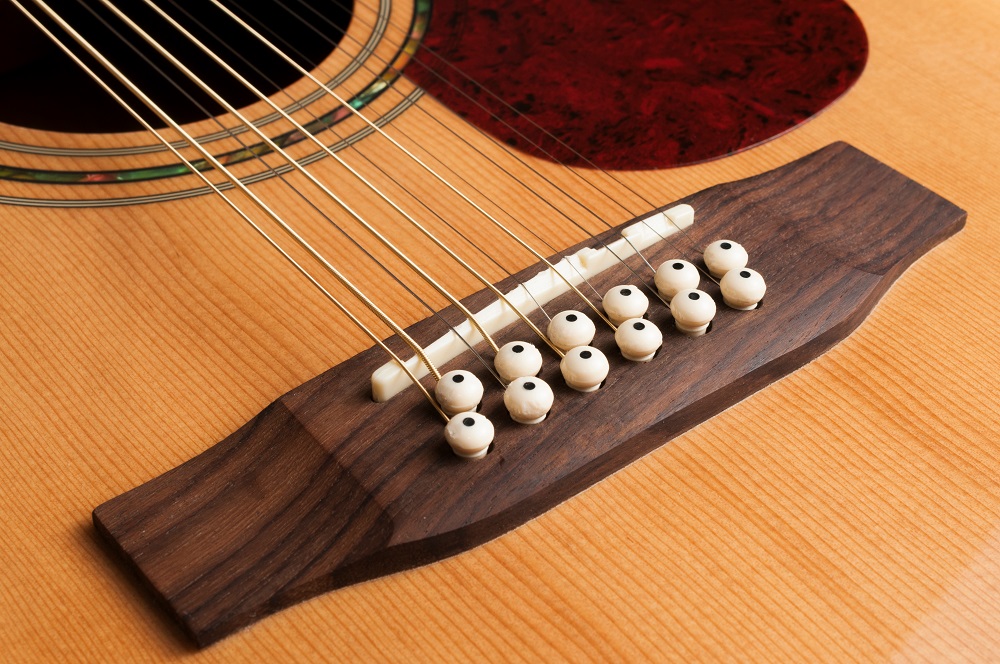There’s no denying the charm and joy that comes with strumming a guitar while basking in the ambiance of the great outdoors.
For many, camping is incomplete without the rustic notes of a perfectly tuned acoustic guitar to amplify the harmony of nature.
However, picking the right instrument to accompany you on your outdoor trips can be a daunting task given the myriad of options available.
Here, we not only aim to provide you with a comprehensive list of the finest guitars suitable for camping, but also key details to help you make the right choice.
This criterion includes factors like portability, sound quality, and durability under various weather conditions.
It is our mission to guide you in finding the ideal guitar to be your companion for every campfire & starlit night.
Table of Contents
- Best Acoustic Guitars For Camping
- Cordoba Mini II M Acoustic Guitar
- Seagull S6 Cedar Original Slim Acoustic Guitar
- Taylor GS Mini Series Acoustic Guitar
- Martin Road Series D-10E Acoustic-Electric Guitar
- Fender Tim Armstrong Hellcat Acoustic-Electric Guitar
- Martin LX1E Little Martin Acoustic-Electric Guitar
- Taylor 114ce Acoustic-Electric Guitar
- Takamine GD30CE-NAT Dreadnought Cutaway Acoustic-Electric Guitar
- Gretsch Guitars G9520 Jim Dandy Flat Top Acoustic Guitar
- Ovation CS24-1 Celebrity Standard Acoustic-Electric Guitar
- Journey Instruments OF660M Carbon Fiber Travel Guitar
- Cole Clark AN2EC Acoustic-Electric Guitar
- Martin LXK2 Little Martin Acoustic Guitar
- Yamaha JR1 FG Junior Acoustic Guitar
- Fender Malibu Player Acoustic Guitar
- What to Look for When Buying Acoustic Guitars for Camping?
- How Do Weather Conditions Affect Acoustic Guitars?
- How to Care for Your Camping Acoustic Guitar?
- What Makes a Guitar Suitable for Camping?
- Are There Acoustic Guitars Specific for Camping?
- Is Your Guitar Safe in a Campfire Environment?
- How to Properly Store Your Camping Acoustic Guitar?
- Can You Travel Easily with Acoustic Guitars?
- Difference Between Regular and Camping Acoustic Guitars?
- How Important is Weight in a Camping Acoustic Guitar?
- The Bottom Line
Best Acoustic Guitars For Camping
Before I begin, here are my top selected choices:
|
|
Cordoba Mini II M Acoustic Guitar

Small body guitar with full-size tone. Check Price
|
Taylor GS Mini Series Acoustic Guitar

Compact Taylor guitar with big, rich sound
Check Price
|
Cordoba Mini II M Acoustic Guitar
Small body guitar with full-size tone.
The Cordoba Mini II M is a 1/2 size, nylon string guitar with a rich, mahogany body. Despite its small stature, it has an extended scale length of 22.875″ that allows it to tune perfectly to standard E. With a unique, mellow voice, this instrument offers a well-rounded tone similar to a full-size guitar.
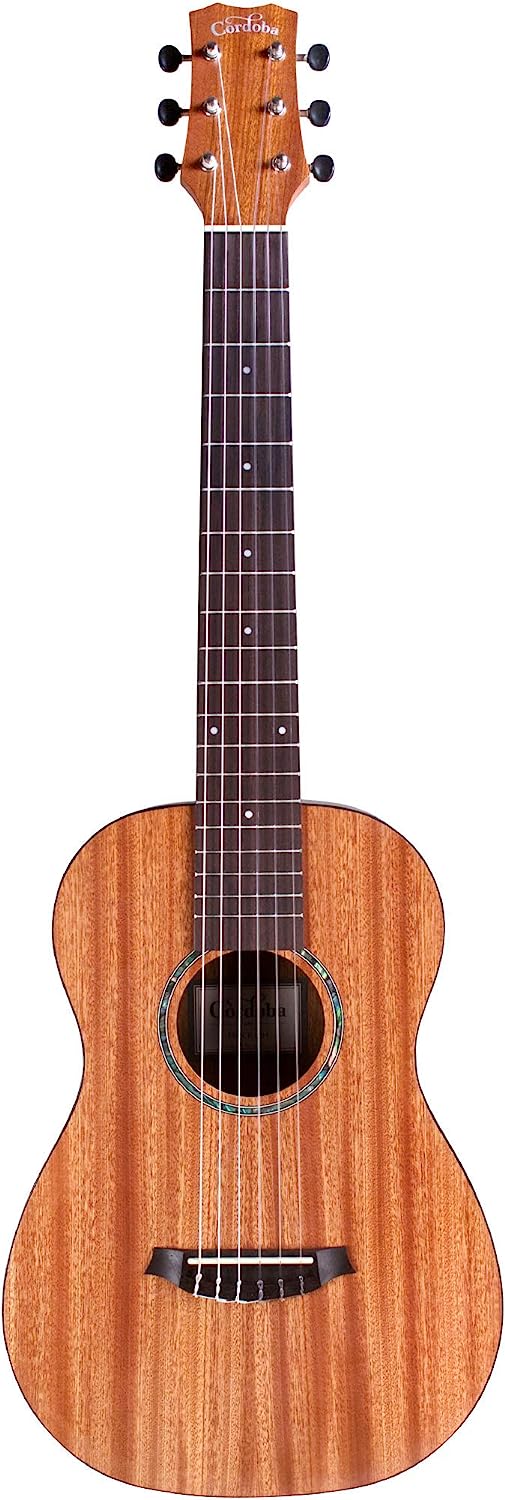
The Cordoba Mini II M is a compact nylon string guitar, expertly crafted from beautiful mahogany wood.
Boasting a comfortable half-size, this guitar is tuned to standard E, making it a great fit for those seeking the full sound of a larger instrument in a travel-friendly format.
With a layered mahogany top, back, and sides, every inch of this guitar is reflective of superior quality and craftsmanship.
Its nub one nut with a width of 1.875″ is accompanied by a C-profile mahogany neck and a scale length of 22.875″ enhancing its playability.
The inclusion of a satin polyurethane finish on both the body and neck promises an elegant aesthetic that perfectly complements the natural beauty of the used mahogany wood.
Speaking of natural beauty, since this guitar is crafted from natural wood, each piece will have a unique color richness and wood grain.
Note that the product that arrives might look slightly different in terms of color depth from the one showcased here due to this natural variation.
To list the most prominent characteristics, this Cordoba Small Body Guitar comes with a mahogany top material type, body material, back material type, and neck material type.
The fretboard, on the other hand, is made of Pau Ferro Wood. Also, it’s designed for right-hand orientation and has six strings made of nylon.
Familiarize yourself with the Mini II MH and you’ll quickly see why it’s a popular choice among musicians.
Despite its compact build, its body depth is deeper, producing a well-rounded tone akin to a full-size nylon string guitar.
You can expect a mellow, soft, and balanced sound unique to mahogany-built instruments.
- My Review
Upon first glance, one cannot ignore the dignified mahogany finish of the Cordoba Mini II M guitar.
Its small body marks a significant deviation from the typically bulky classical guitars, which, suffice to say, makes handling much more comfortable.
This half-size guitar is incredibly lightweight, offering the ease of portability and making it a rather appealing travel companion.
Despite its size, it boasts a rich and well-rounded tone, comparable to that of a full-size guitar, due to its deeper body depth.
You’d expect a compromise in sound quality due to this design, however, the mellow, soft and balanced music it produces is quite a delightful surprise.
The neck is a C-profile mahogany affair, topped with a Pau Ferro wood fretboard, which gives a decent experience to the seasoned guitarist as well as the novice, bringing together ease and refinement.
The fret spacing seems to be just right, not too scrunched, providing a playing comfort that keeps your fingers happy.
However, I did notice that the marker dot is on the 9th fret instead of the 10th – a minor concern but one worth pointing out.
I found the Nylon strings a tad average, but remember you have the freedom to replace them as per personal preferences.
One bone strictly to pick with this product though is the wider NuBone nut with a 1.875″ width, making playing a bit of a challenge at times.
I also noticed that the guitar tends to go out of tune rather quickly, which means you might find yourself tuning it more often than you’d like.
However, for the price, the sturdiness and overall build quality of the guitar is quite impressive.
It’s worth mentioning how well the satin polyurethane finish on the body and neck enhances the natural variation of the wood color, adding a good deal of character to each instrument.
The extended 580mm (22 7/8”) scale length for standard E tuning is a nice touch, making it a versatile pick.
In spite of small limitations, I believe this particular cordoba guitar does a good job at appealing to a wide customer base, from beginners to experienced guitar aficionados.
An overarching sentiment, it seems, is that this guitar is truly a value-for-money purchase, with an easy portability.
- Pros:
- Comfortable size and lightweight.
- Good for young beginners.
- Balanced, mellow sound.
- Cons:
- May go out of tune quickly.
- NuBone nut width could be uncomfortable.
- Sound might not satisfy experienced users.
My final verdict is that the Cordoba Mini II M Mahogany, Small Body, Nylon String Guitar is excellent for both travel and standard use.
The rich, balanced tones it produces rivals those of a full-size guitar, thanks to its deeper body depth and all-mahogany construction.
Furthermore, its comfortable size and standard tuning make it an easily accessible instrument for all skill levels.
Also, the guitar’s aesthetic, with the unique spirit and varied richness of natural wood, is very pleasing.
The Cordoba Mini II M is a resilient, stylish, and high-quality instrument worth investing in.
Seagull S6 Cedar Original Slim Acoustic Guitar
Seagull S6 Offers Custom Stain and Slim Design
This slim acoustic guitar from the brand Seagull features a solid cedar top and wild cherry back and sides, with a deep custom stain for added aesthetics. The fingerboard is crafted from rosewood, offering a smooth experience for right-handed musicians. Equipped with six strings and a 25.5-inch scale length, the instrument produces an excellent tone quality.
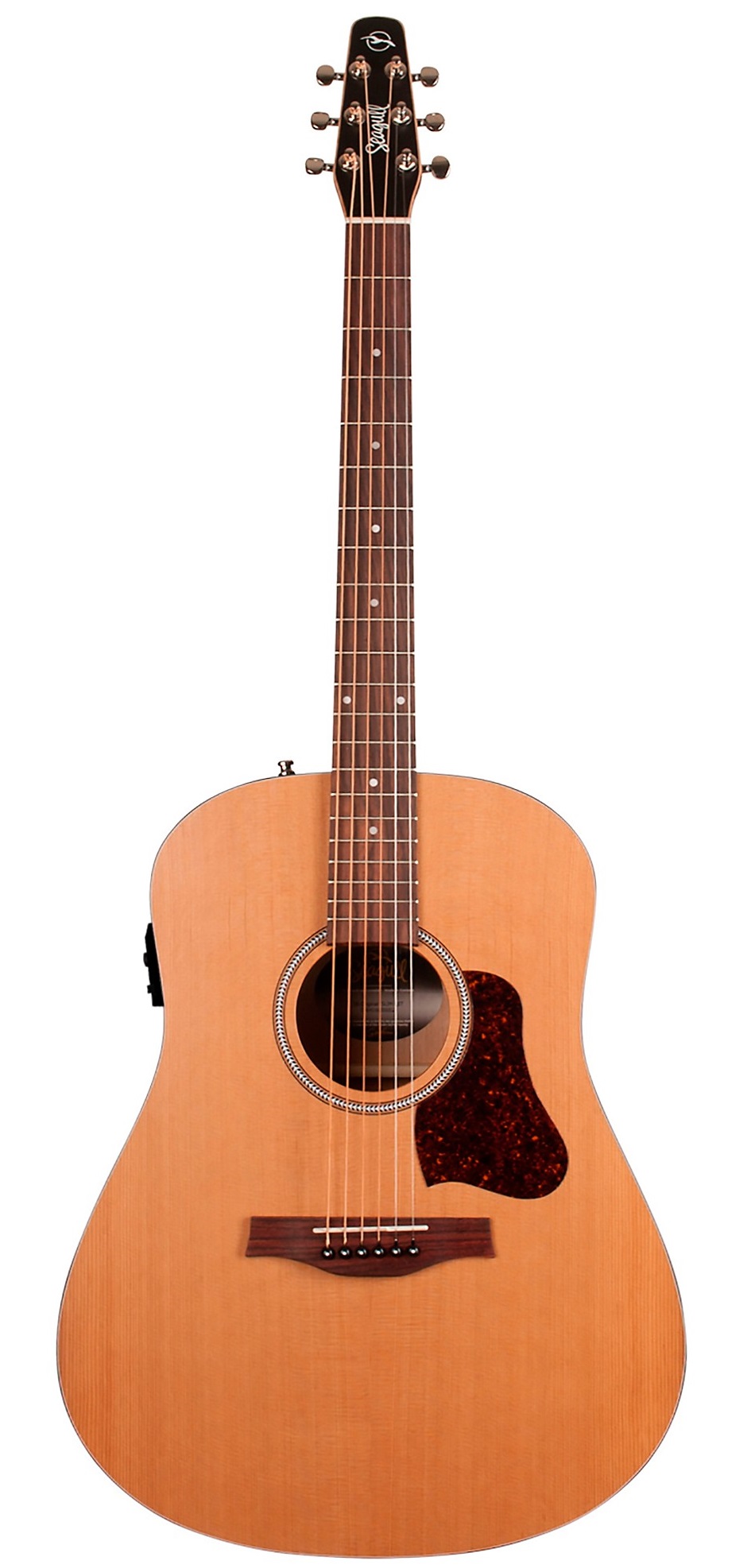
The Seagull S6 Cedar Original Slim Acoustic Guitar is a remarkable instrument crafted with a rosewood fingerboard and a semi-gloss look.
What sets it apart is its unique deep, dark custom stain on the wild cherry back and sides.
This guitar also features an all-new custom pick guard.
Its top is made from pressure-tested solid cedar, which ensures durability.
The same deep, dark custom stain is also utilized on the instrument’s neck and headstock, giving it a unified and distinct look.
It has a slimmer nut width of 1.72 inches which offers the ease of fret transitions.
With regards to the brand, it’s a masterpiece from Seagull.
The top of the guitar combines both rosewood and cedar wood, delivering a great tone.
Rosewood and cedar materials are used to form the body, with cherry wood taking the back.
The neck is made of mahogany, coupled with a rosewood fretboard for that extra resonance.
Designed for right-handers, it comes with a scale length of 25.5 inches for a full-size playing experience.
This acoustic guitar is a six-stringed musical tool, making it a versatile choice for all music genres.
While offering its functionality, it remains an original natural guitar.
- My Review
My experience with the Seagull S6 Cedar Original Slim Acoustic Guitar was truly remarkable.
Handling it, I appreciated the deep dark custom stain on the wild cherry back and sides that advances its classic aesthetic appeal.
The design also features a significant inclusion of a new custom pick guard.
As I strummed the guitar, it became obvious that the solid cedar pressure tested top played a crucial role in producing the distinct and rich tone.
Plus, the well-crafted neck and headstock, also sporting the deep dark custom stain, complemented the overall look and feel of the instrument.
I found the slimmer 1.72″ nut width to be beneficial for my playing comfort, albeit, it admittedly necessitates a level of finger dexterity to prevent striking the wrong strings.
This Seagull construction uses a mix of rosewood, cedar wood, mahogany and cherry wood, contributing to its exquisite tonality and durability.
I found the choice of right-hand orientation and a scale length of 25.5 inches as standard features contributing towards better playability, especially for beginner and intermediate players.
Being a 6-string acoustic guitar, the Seagull S6 Slim puts forward both an impressive tonal spectrum and playing flexibility.
I appreciate the fact that it held its tune particularly well despite the traditional tuning system, with useful and easy-to-adjust tuning pegs.
Presumably, because the guitar comes equipped with decent strings, playing it was both comfortable and rewarding to the ears right out of the box.
Its great action and impressive performance in both quietly executed notes and louder strumming were delightful and distinct.
I did, however, notice that due to its robust construction, it might appear quite large and potentially intimidating for some, especially beginners.
But in my opinion, it is well worth overcoming this initial trepidation given the excellent value to performance ratio.
Your fingers may require some practice to smoothly navigate between the closely-pack string setup, but with time this will likely no longer pose as a concern.
Although it does indeed deserve its slight learning curve, my conviction is that its exceptional features and unbelievable value make the Seagull S6 Cedar Original Slim Guitar a worthy investment for any guitar enthusiast.
- Pros:
- Great tune and action.
- Incredible value for performance.
- Comes with decent strings.
- Cons:
- Strings closer together on slim.
- Size of the guitar is large.
- May seem intimidating to beginners.
My final verdict is that the Seagull S6 Cedar Original Slim Acoustic Guitar is a high-quality instrument that provides a delightful acoustic experience.
Its solid cedar pressure-tested top and rosewood fingerboard deliver a clear and exquisite tone, whilst its deeper, dark custom stain adds a touch of elegance.
Moreover, the slim nut width and the general craftsmanship of the guitar offer a comfortable play for the user.
Therefore, this is an excellent instrument for both beginners and experienced guitar players alike.
The Seagull S6 Cedar Original Slim Acoustic Guitar presents an impressive blend of great sound, structured build, and elegant design.
Taylor GS Mini Series Acoustic Guitar
Compact Taylor guitar with big, rich sound
Featuring a compact design for portability, this acoustic guitar boasts a Sitka spruce top with laminated Indian rosewood back and sides for a rich, full sound. It has an ebony fingerboard and a scale length of 23.5 inches. Despite its smaller stature, it delivers impressive sound, a testament to Taylor’s superior craftsmanship.
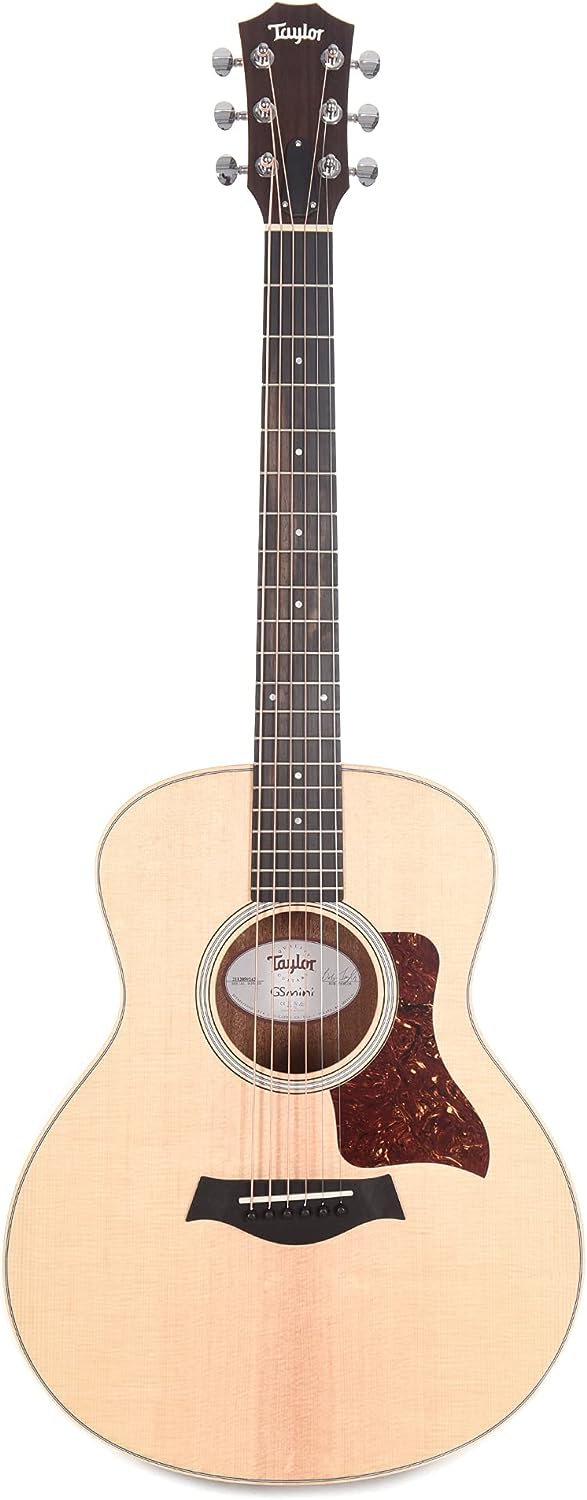
The Taylor GS Mini RW is an acoustic guitar that delivers exceptional sound in a small package, offering the renowned quality of the Taylor brand.
Designed after the widely appreciated Grand Symphony style, this compact guitar is made for mobility but doesn’t compromise on its output.
Contrary to the common notion associated with small guitars, this model does not come up short on sound, all thanks to the superb craftsmanship of the, Taylor’s luthiers.
It boasts a Sitka spruce top, providing a quality tonewood that enhances the guitar’s overall resonance and tone.
The back and sides of the guitar are comprised of laminated Indian rosewood which adds both to the durability and the aesthetics of the guitar.
Featuring a smooth ebony fingerboard, this instrument ensures a comfortable playability for the player.
With the body, neck, and top all made of rosewood, this guitar also sports an all-natural finish, aligning with a classic style.
The guitar is strung with phosphor bronze strings, which are known for their warm tone and remarkable durability.
Designed for right-handed players, it also features a relatively short scale length of 23.5 inches, which contributes to its compact style.
This guitar also comes with a gig bag for easy transportation, a beneficial addition for touring musicians or those regularly on the move.
The Taylor GS Mini RW acoustic guitar is a portable, rich-sounding instrument that proves size doesn’t always matter.
- My Review
As I cradled the Taylor GS Mini RW acoustic guitar in my arms for the first time, I was immediately drawn to the superb craftsmanship and build quality.
Upon strumming its six strings, its rich and full sound had me instantly smitten; a remarkable achievement given its reduced size – a fact not lost on me as it defied expectations that smaller guitars often fall short on sound.
The outstanding resonance of this guitar, I perceived, can be attributed to the Sitka spruce top which as I later discovered, has properties favored in sound board construction.
Taking a closer look at the guitar, I noticed the laminate Indian rosewood back and sides.
My research informed me that laminate wood is often more resilient to changes in humidity and temperature, enhancing the durability of this fine instrument.
I also found that this guitar featured an interesting detail, a bellyarch at the back which I was initially puzzled by – it turns out that it is part of the guitar’s design which reportedly contributes to its wonderful sound.
Complementing the spruce and rosewood components is the ebony fretboard, often preferred by experienced guitarists due to its smooth feel and wear resistance.
The strings, made from phosphor bronze, struck a chord with me due to their bright, warm tone.
I must point out that the Taylor GS Mini came well packed in a gig bag – not only a practical addition for transporting the guitar but a statement of the brand’s careful attention to detail.
I played this guitar indoors, outdoors, and in various settings, each time the sound was persistently flattering, a huge testament to the guitar’s versatility.
Despite its compact size, I believe this guitar is not confined to just travel or practice sessions but can also deliver on stage performance.
One thing that really stood out for me was how well the guitar held its tune, even after long practice sessions.
Despite its portability and compact size, I found that the Taylor GS Mini RW offers real substance worthy of both amateur and professional musicians.
Ultimately, the combination of carefully selected materials, expert craftsmanship, and thoughtful design all contribute to the high-quality sound and overall value of the Taylor GS Mini RW acoustic guitar.
- Pros:
- Excellent sound quality.
- Impressive build and craftsmanship.
- Compact size, perfect for travel.
- Cons:
- No mention of body’s bellyarch design.
- Not part of prime 2-day shipping.
- Potentially more expensive than competitors.
My final verdict is that the Taylor GS Mini Rosewood Acoustic Guitar is nothing short of excellence.
Its compact size doesn’t compromise the performance, but rather delivers an amazingly rich and full sound.
With materials such as Sitka Spruce and Indian Rosewood, it stands out not only in sound quality but also in aesthetics.
I would highly recommend this to anyone who values superb sound quality in a compact, travel-friendly package!
Martin Road Series D-10E Acoustic-Electric Guitar
Solid wood, stunning design, equipped with Fishman MX-T electronics.
This guitar consists of carefully selected materials like Sitka spruce top and sapele back and sides, offering robust sound at an affordable price. It features Fishman MX-T electronics package with an inbuilt soundhole tuner for instant fine-tuning. Moreover, the satin finish body, mother-of-pearl pattern inlays, and a high-performance taper neck ensure a comfortable playing experience.
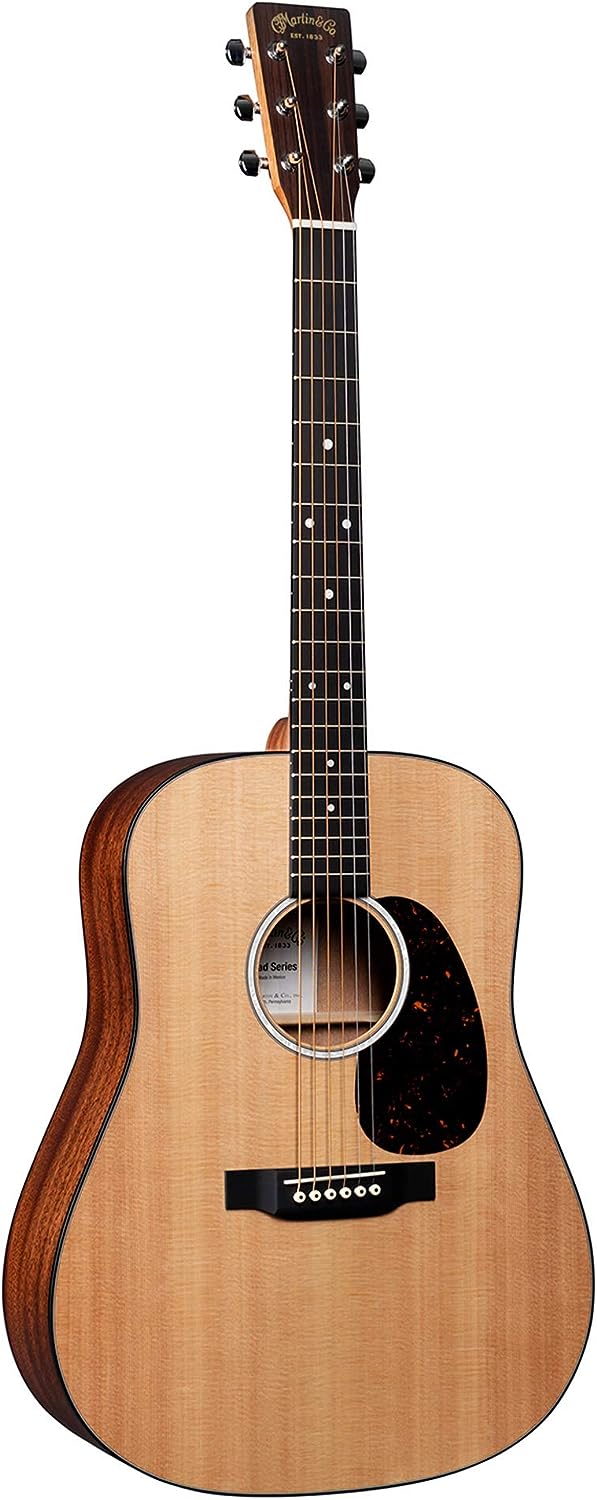
The Martin Road Series D-10E is a classic model, covered in a satin finish, with composition from sapele wood and spruce wood, giving it an elegant natural color.
Notably, the top and back are made of Sapele wood while the neck is crafted from pure wood.
To add to the luxurious finish, the fingerboard is created from Richlite, presenting a remarkable mix of materials.
Whether you’re a right-handed player or perhaps favor the left, the guitar is designed for right-hand orientation for versatility to different users.
The guitar contains a scale length of 25.4 inches and consists of six strings, perfect for producing a rich and full tone.
This acoustic model is made with dreadnought in mind, using expensive materials such as Sitka spruce and sapele in its make up.
It comes with a Fishman MX-T electronics package, complete with an inbuilt soundhole tuner that automatically mutes the audio output when tuning, sidestepping the need for a pedal.
The dreadnought guitar model is also accompanied by a Premium soft shell case which means you can take your music on the road without worrying about damaging your instrument.
This particular model doesn’t fall short in aesthetics either, with magnificent mother-of-pearl pattern fingerboard and rosette inlays that are accented by a multi-stripe rosette border.
The neck tapers in a high-performance manner and the body is completed with a hand-rubbed neck finish, denoting the careful craftsmanship involved in creating this musical masterpiece.
- My Review
As an avid lover of music, I can boldly say that stepping foot into the realm of the Martin Road Series D-10E Satin Sitka/Sapele Natural guitar offers an appealing allure.
In my grasp, the alluring touch of the Sitka Spruce and Sapele wood body invigorates a feeling of quality craftsmanship.
Observing it carefully, the mother-of-pearl pattern fingerboard and rosette inlays, along with a multi-stripe rosette border, indeed make a statement: this is not just another guitar.
As I strum the strings, it has an extraordinary sound, a testament to the high-quality materials.
It’s noteworthy, Martin incorporates a Fishman MX-T electronics package complete with a built-in soundhole tuner that enables you to tune up at any time without using a pedal.
Upon assessing its functionality, I noticed a bit of a snag.
The action seems a tad high for my liking, and the strings felt somewhat heavy.
Nonetheless, all these are correctable with some adjustments to suit personal preferences.
Additionally, the perceived slight inconsistencies with the tuning machines can be seen as a bit of a drawback.
There were instances where they slipped or snapped out of tune, yet I feel this issue, though vexing, does not overshadow the overall quality of the guitar.
Lastly, I wish it came with volume controls to give more optimization in sound production, which seems a bit of an oversight for the martin’s excellent design standard.
One cannot oversee the guitar’s remarkable aesthetics.
Its satin finish body, coupled with a hand-rubbed neck finish, oozes sophistication.
Comfort undeniably has a big part to play in choosing a guitar and this model adequately ticks that box.
However, I must admit that the fretboard width felt a smidgen uncomfortable to my grasp.
On the other hand, while the physical weight of the guitar may come across as hefty to some, I find it contributing to the sense of durability and quality.
In the direct light of scrutiny, the Martin Road Series D-10E has a few quirks that may require adjustments to suit individual preferences.
Yet, its superb craftsmanship and iconic sound make it a compelling choice for anyone who is passionate about guitars.
This guitar while representing an investment, does stand up to the expectations of the Martin lineage and offers a premium and robust musical experience.
- Pros:
- Excellent sound quality.
- Premium craftsmanship.
- Included soft shell case.
- Cons:
- Issues with inbuilt tuner.
- Action may be high for some.
- Possible fretboard bump at 12th fret.
My final verdict is that the Martin Road Series D-10E Satin Sitka/Sapele Natural is a top-notch option for guitar enthusiasts.
Its superior build quality featuring sapele and spruce woods, along with the Richlite fretboard, delivers unparalleled durability and exceptional sound resonance.
The fact that it comes with a premium soft shell case and Fishman MX-T electronics, including a built-in soundhole tuner, suggests that it’s remarkably value-packed for its price range.
Highly recommended for those valuing a fusion of classical craftsmanship and modern features.
Fender Tim Armstrong Hellcat Acoustic-Electric Guitar
Iconic design meets sound quality in Fenders Hellcat
Constructed with a solid Mahogany top, laminated Mahogany back and sides, and a rosewood bridge, this acoustic-electric guitar features Fishman Isys III system for superior sound quality. This guitar boasts unique style elements such as Hellcat and skull inlays and Tim Armstrong’s signature. Equipped with bronze strings and combination pickup configuration, it delivers a modern, punk-inspired performance ready for any stage.
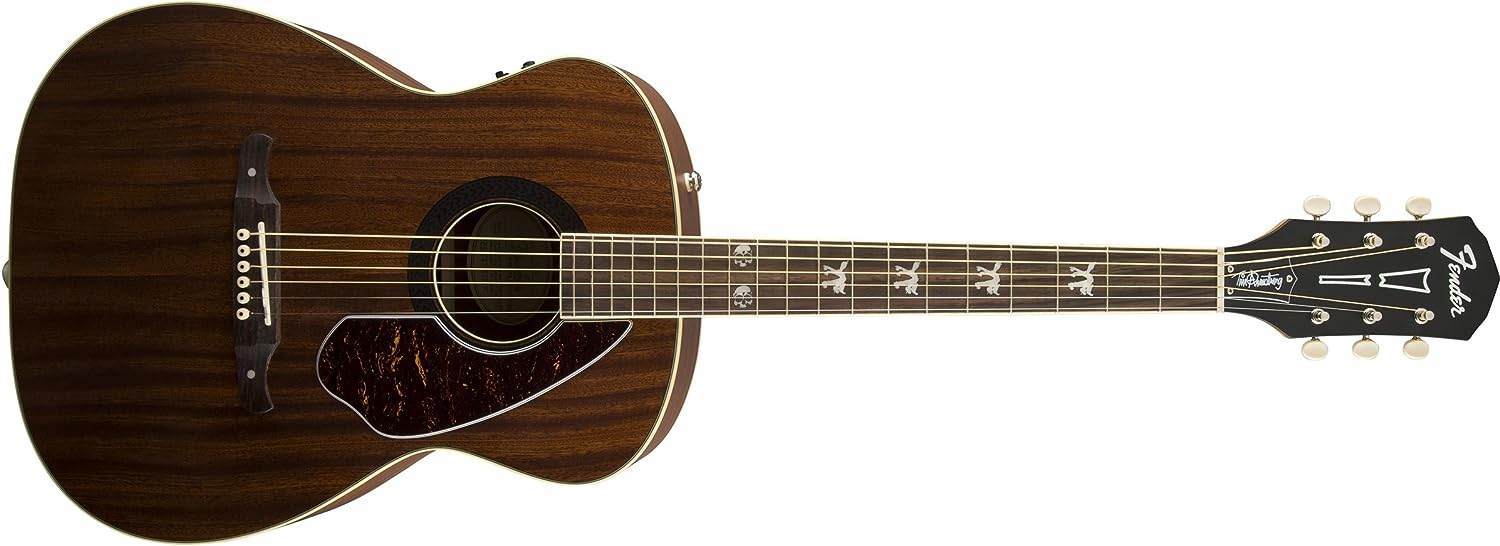
The Fender Tim Armstrong Hellcat Acoustic-Electric Guitar boasts of a natural finish that gives it an authentic touch.
Its body is cococted from solid Mahogany on top, with a mix of laminated and solid wood for the rest of the body and Mahogany at its back, creating a premium feel and texture.
Adding an intricate touch are Scalloped X Bracings that contribute to the fine detailing of this guitar.
It’s fitted with the efficient Fishman Isys III System that enhances its performance.
The bridge of the guitar is built with Rosewood, incorporating a Compensated Saddle and chrome die-cast tuning keys providing stability in tuning the instrument.
Bringing uniqueness to its design are a 4-Ply Tortoise Shell Pickguard, Hellcat inlays at certain positions, Double Skull Inlays at the 12th fret, and Tim Armstrong’s autograph on the Truss Rod Cover.
Maple forms the material for its neck, while the ombination pickup configuration gives it versatility.
The guitar strings are made of Bronze, bringing a rich, warm tone to the overall sound.
This particular guitar model was inspired by Tim Armstrong’s personal ’60s Fender acoustic, a staple in his songwriting process for his renowned punk rock band, Rancid.
Its signature feature includes pearl acrylic “Hellcat” logos on the third, fifth, and seventh frets, with couple of skulls highlighting the 12th fret.
Other modern features that make it stand out include a Fishman® preamp with a built-in tuner, strap button, and scalloped bracing.
Crafted with attention to detail, this guitar is perfect for those looking for an instrument with a touch of unique flair and style.
- My Review
First off, let’s dive into the construction and materials of the Fender Tim Armstrong Hellcat Acoustic-Electric Guitar in natural finish.
Upon close examination, I found the structure to display a well-balanced blend of solid mahogany top along with laminated mahogany back and sides.
The scalloped X bracing feature adds a significant rigidity to the guitar, enhancing its resonance and offering a rich, full-bodied sound that’s remarkably satisfying for any musician.
Housed under the rosewood bridge is the compensated saddle, which works neatly along with the chrome die-cast tuning keys to ensure accurate and consistent tuning.
Equally noteworthy is the well-integrated Fishman Isys III system which amplifies the acoustic tones smoothly, making the guitar suitable both for home practice and live performance scenarios.
However, the craftsmanship could use some refinement, especially around the fingerboard binding – the aesthetic appeal is slightly marred by an uneven finish, which some may find undesirable.
In terms of aesthetics, it’s hard not to mention the 4-Ply Tortoise Shell Pickguard, Hellcat Position Inlays, Double Skull Inlays at the 12th Fret, and Tim Armstrong’s signature on the truss rod cover – these features provide a mix of vintage and punk aesthetics that are unique to this particular model.
And, of course, not forgetting the cream body bindings, the black painted headstock, the urea nut and saddle, and the black with white dot bridge pins.
Moving on to the playability, the sleek maple neck coupled with the rosewood fretboard enables a smooth and comfortable playing experience.
The guitar comes strung up with bronze strings, that add to its vibrant and well-balanced sound output.
However, some may find a slight trouble with the fret buzz, which I noticed was persistent in certain scenarios and might require additional setup to minimize.
Aside from its distinctive appearance and build, another key selling point of this instrument is its affordability — it doesn’t break the bank, making it an ideal pick for those who want a quality acoustic-electric guitar without spending an arm and a leg.
Yet, it’s also essential to remember that its low price does come with certain compromises, particularly in terms of the finish and overall craftsmanship.
Despite a few minor concerns, the Fender Tim Armstrong Hellcat Acoustic-Electric Guitar boasts a compelling mix of sound quality, unique aesthetics, and affordability, making it a worthwhile consideration for musicians across varying expertise levels.
- Pros:
- Exceptional sound quality.
- Unique inlays and vintage feel.
- Built-in preamp and tuner.
- Cons:
- Possible issues with build craftsmanship.
- May require frequent string replacements.
- Tone might disappoint some users.
My final verdict is that the Fender Tim Armstrong Hellcat Acoustic-Electric Guitar is perfect for punk rock enthusiasts and fans of Rancid’s Tim Armstrong.
The solid mahogany top along with the Fishman preamp and the built-in tuner enhances any performance and gives it a distinctive sound.
Furthermore, the aesthetic details such as the Hellcat logos and double skull inlays at the 12th fret add a unique, rebellious touch to the guitar.
Whether you’re performing on stage or doing jam sessions at home, this guitar’s versatility and excellent craftsmanship make it a great investment.
Martin LX1E Little Martin Acoustic-Electric Guitar
High-quality, versatile and durable acoustic-electric guitar.
This small yet powerful instrument, the Martin LX1E Little Martin, boasts a solid Sitka spruce top and mahogany high-pressure laminate construction. It enriches any music style with its unparalleled tone and enhanced playability. Crafted from premium wood, the guitar’s durability shines through in jam sessions, studio use, or simply casual strumming.
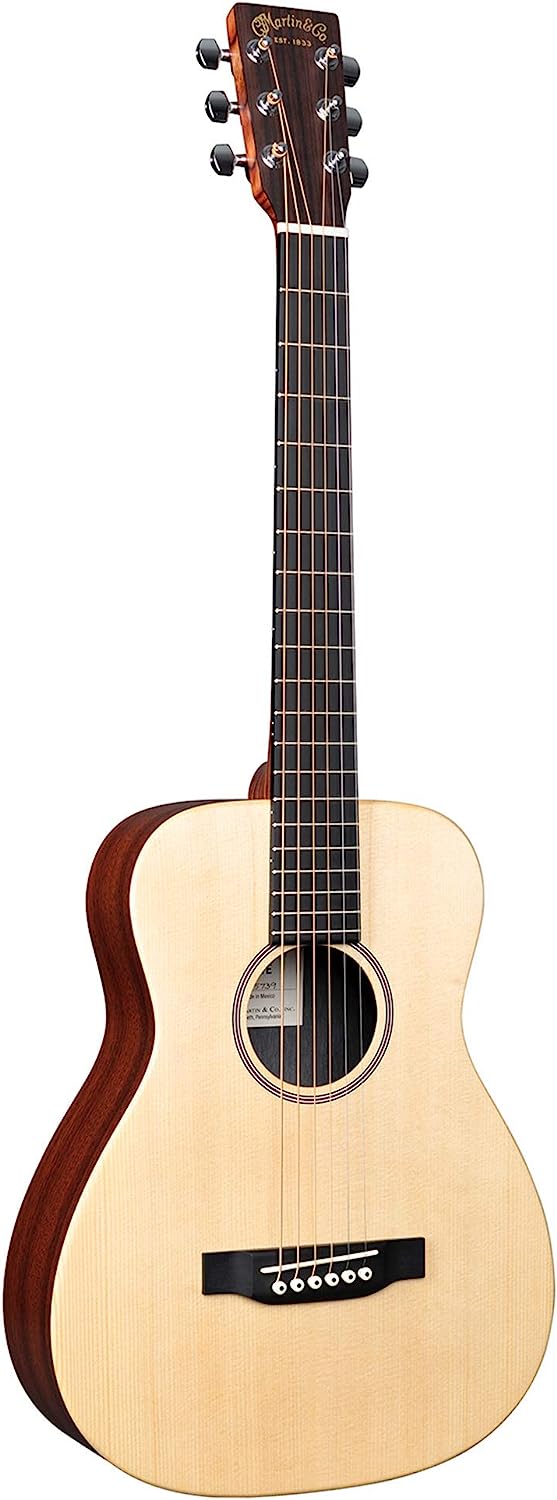
Introducing the Martin LX1E Little Martin Acoustic/Electric guitar, a combination of compact design and professional sound.
This mini version of a guitar, manufactured by Martin, boasts a high-quality, sensational Sitka spruce top and high-pressure laminate (HPL) structure.
Though small in dimension, this guitar does not compromise on its depth of sound, versatility or tone quality. It is equally impressive for a casual jam around a campfire or an intense home practice session.
From the aesthetic point of view, this acoustic-electric instrument stands out with its mahogany HPL back, sides and enchanting warm satin finish.
It is crafted with sustainable wood certified parts, making it not just beautiful but eco-friendly too. Furthermore, it features a mortise and tenon neck joint, non-scalloped X-Brace, standard tapered neck, and chrome-enclosed gear tuners.
The guitar’s construction involves the highest-quality wood, making it resilient to long studio sessions, intense strumming or picking.
Along with its iconic worldwide known tone, Martin guitars offer outstanding playability, adaptable to any genre from rock to jazz, making guitar-playing an enjoyable experience for everyone, regardless of their skill level.
This Little Martin LX1E guitar is right-handed with a neck made of mahogany and a fretboard of Morado. It uses phosphor bronze strings and comes with Fishman Isys T electronics.
Made with superior materials, these guitars uphold a timeless style with innovative designs, offering a variety of solid wood options catering to a wide range of music genres and individual playing styles. Ideal as a starter guitar, it can be taken anywhere due to its smaller size.
- My Review
Upon receiving the Martin LX1E Little Martin Solid Sitka Spruce/Mahogany HPL Acoustic/Electric guitar, I was instantly taken by its superior appearance.
It boasts a captivating design, extending to the spruce top and high-pressure laminate construction, which demonstrated unquestionable validity of its professional sound.
I found that when it came to sound, its size did not compromise on quality or versatility.
Ringing chords around a campfire or practicing at home, it was delightful to discover that the guitar sounds fantastic in both settings due to its excellent tone and high quality.
This guitar, despite being sturdy, is not cumbersome to move around with.
Its compactness accommodates the convenience of travel, making it feasible for an unplanned jam session or studio recording.
Although I had some initial reservations about its durability with extended use, my fears eased over time due to the solid construction, especially for late-night jams, and long studio sessions.
Something note-worthy about this guitar is its enhanced playability.
As an experienced guitarist, I noticed immediately the ease of playing, regardless of the type of music – rock, country, folk, bluegrass, or jazz.
I also took note that its handmade construction – from its highest-quality wood – justified the belief that these guitars are carved to withstand regular strumming or picking.
I was slightly thrown off by the fact that it’s not as balanced when you’re standing with the guitar strap.
However, this is a minor setback as it could be due to its compact and travel-friendly nature.
One of the impressive features I found was the high-pressure laminate which not only looked great but seemed quite durable.
For people like me, who enjoy the sweet sound of acoustic guitars with a pinch of modern technology, the Fishman Isys T pickup configuration is spot on.
Amplifying the guitar’s natural acoustic sound, it brings a different dimension to the music that is hard to resist.
Nevertheless, I noticed the string buzz when strumming moderately-hard on the high E string, caused the nut was cut a bit low.
Deal breaker? Not quite, as this is an issue common to many guitars and can be easily fixed by visiting a dealer.
Despite these minor issues, this is an excellent guitar, projecting a good amount of depth and clarity in the music it helps create.
- Pros:
- Superior sound quality.
- High-quality construction.
- Enhanced playability.
- Cons:
- Limited warranty period.
- May have balance issues.
- Some found sound subpar.
My final verdict is that the Martin LX1E Little Martin is a high-quality acoustic-electric guitar that is worth buying.
Its compact size and professional sound make it perfect for both at-home practice and outdoor jamming.
The sustainable wood construction and superior materials promise durability and a timeless warm tone.
Also, its enhanced playability caters to players of all skill levels and musical genres.
It is a reliable, versatile, and high-performing instrument, representing the unrivaled craftsmanship of the Martin brand.
Taylor 114ce Acoustic-Electric Guitar
High-quality Taylor guitar with unique wood combination.
This acoustic-electric guitar boasts a spruce top and walnut back sides. Crafted with an ebony fretboard and a walnut neck, it’s designed for left-hand orientation with a tune-o-matic bridge system. Its distinctive Grand Auditorium shape creates immersive sounds, making it a perfect choice for music enthusiasts.
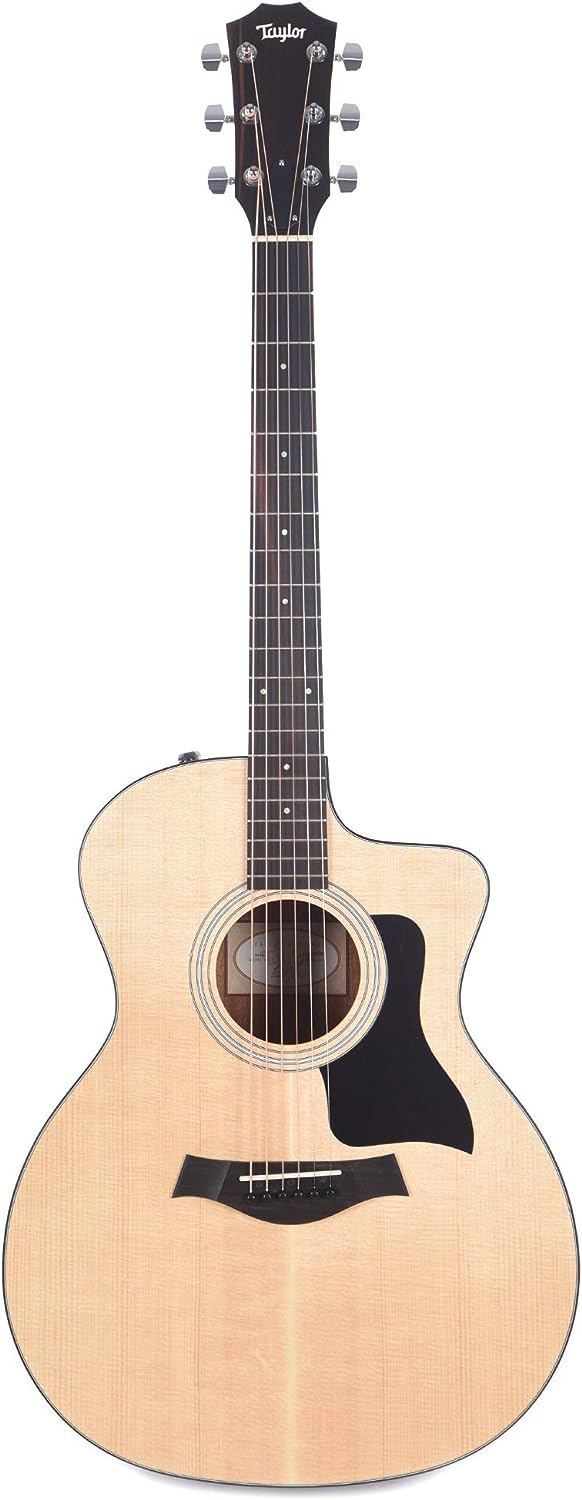
Have you heard about the Taylor 114ce Acoustic-electric guitar? It brings together the best of both worlds for musical enthusiasts who adore the natural allure of instruments.
This guitar is a six-stringed acoustic-electric blend ensuring a dynamic playing experience. It boasts a top made of spruce, enhancing its vibrant tone.
The fretboard on this beauty is crafted from exquisite ebony, a material that is loved for durability and a smooth feel.
What sets this guitar apart is its make, with a walnut back and sides along with a sturdy maple neck, which all contribute to the overall tone and sustain a guitarist requires.
Under the renowned brand of Taylor, this guitar has a natural hue, which makes it visually appealing amidst its counterparts.
The top material type incorporates a blend of ebony wood and sapele wood, enhancing its aesthetics and durability.
The body of this guitar is composed of a walnut laminate, lending to its unique sound resonance capabilities. The neck material is walnut wood, adhering to the design aesthetics and providing structural sturdiness.
Going a little further, the fretboard is of ebony wood, which is ideal for an excellent playing experience. The guitar comes with nylon strings, perfect for a softer sound.
This guitar accommodates left-handed players with absolute ease. It has a Tune-O-Matic guitar bridge system, an addition that improves tonal clarity.
If you’re looking to explore a distinctive grand auditorium inside this guitar, the Taylor 114ce Acoustic-electric guitar will never disappoint you.
- My Review
Diving right into the review of the Taylor 114ce Acoustic-electric guitar, this instrument is an absolute performer.
It’s an all-rounder guitar that I came to enjoy for its superior sound and construction quality.
When I picked it up, I immediately noticed the natural, radiant color of the guitar – a blissful sight for any music enthusiast.
But let’s not judge this beauty merely based on its outward appearance.
Upon close inspection, I found a fusion of Ebony wood and Sapele wood at the top.
Match that with the walnut laminate for the body, and you’ve got yourself a musical instrument that doesn’t just look great, but also plays excellent.
I was particularly taken with the harmonious balance of the walnut wood neck and ebony fretboard, making it a craftsmanship marvel to behold.
As someone who’s left-handed, I was delighted to find that the guitar could accommodate my hand orientation.
This, coupled with the Tune-O-Matic guitar bridge system, redefines comfort and playability for me.
When plugged in, I adored the tonal range produced by its strings that were just buzzing with life.
What particularly stood out to me was the guitar’s mid-range punch and how it emanated plenty of presence, outdoing most dreadnoughts in sheer volume.
The sound truly jumps off the strings, and I just can’t help but be swept away by the raw emotion and power that it brings.
As I ventured further into the playing experience, I appreciated its tapered neck that lent a familiar feel of an electric guitar.
Being able to write songs on this guitar for a long time, I realized, was not a far-off dream.
I must admit, though, there’s a bit of a learning curve involved when it comes to the electronics of this guitar.
While they aren’t the best for recording, they are indeed adequate for stage performance when mic’d up.
In terms of durability, this guitar is a relentless performer, hardly faltering despite a few accidental falls.
The guitar’s performance capability coupled with its solid build makes the Taylor 114ce guitar a hard-to-beat option in its range.
- Pros:
- Distinct walnut back and sides.
- Tonewood amp compatible.
- Reliable and durable.
- Cons:
- Electronics could be improved.
- Excessive mid-range sound.
- Composite back and sides, not solid wood.
My final verdict is that the Taylor 114ce Acoustic-electric Guitar is an exceptional instrument.
With its high-quality materials including Spruce Top, Ebony Fretboard, Walnut Back Sides, and Maple Neck, you’re getting a guitar designed for optimum performance.
The distinctive Grand Auditorium style coupled with a Tune-O-Matic bridge system further enhances its sound and playability.
Despite being left-handed, its versatility and top of the line specs make it a worthy investment for anyone serious about their music.
Taylor 114ce is a premium acoustic-electric guitar that resonates excellence.
Takamine GD30CE-NAT Dreadnought Cutaway Acoustic-Electric Guitar
Stage-worthy guitar with superior sound and playability.
This acoustic-electric guitar is ideal for stage performances, boasting a solid spruce top with mahogany back and sides for a rich sound. The slim mahogany neck and rosewood fingerboard ensure comfortable playability. With a built-in tuner, three-band EQ, and gain controls, the superior electronics allow for impressive amplified performance.
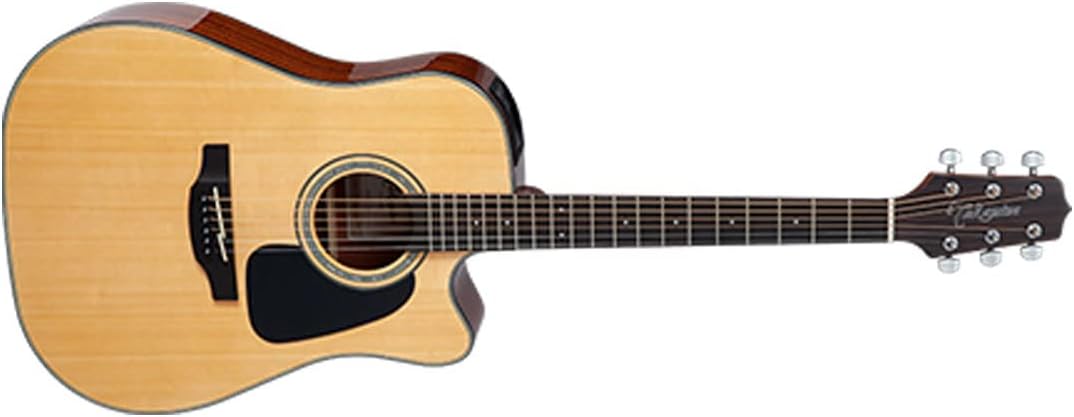
If you’re looking for an acoustic-electric dreadnought guitar, the Takamine GD30CE-NAT is worth your attention.
Primarily crafted with a solid spruce top and mahogany back and sides, the guitar is capable of yielding a profound and resonating sound.
Its slender mahogany neck, coupled with the 12″-radius fingerboard made of rosewood, conforms well to the hand, promoting superb playability and feel.
The Takamine TP-4TD preamp system incorporated within the guitar is a game-changer. This unique feature incorporates a three-band EQ, gain controls, and a built-in tuner, escalating its performance versatility when amplified.
The pin-less rosewood bridge is another intriguing feature of this guitar, subtly contributing to its overall aesthetics with a natural glossy finish.
This guitar is striking, readily prepared for any performance situation with its solid top construction, soft Venetian-style cutaway, and quality electronics system by Takamine.
The onboard Takamine TP-4TD preamp system not only provides a built-in tuner but also equips the instrument with gain controls and a three-band EQ for amplified versatility.
Additional notable features include a synthetic bone nut, split bridge saddle, a rosewood head cap, pearloid rosette, dot inlays, as well as chrome die-cast tuners.
Both available in Natural and Black, the Takamine GD30CE-NAT is not just a guitar; it’s an experience in acoustic-electric excellence.
- My Review
As a seasoned guitarist, I was particularly excited to try out the Takamine GD30CE-NAT Dreadnought Cutaway Acoustic-Electric Guitar in a natural finish.
First thing that caught my eye was the impressive craftmanship.
The guitar showcases a solid spruce top and mahogany back and sides that contributes to a rich, resonant sound.
One feature I am not entirely satisfied with is the intonation of the neck, which initially seemed a bit high for my preference.
Nevertheless, this did not significantly hinder my playing experience as the slim mahogany neck and 12″-radius rosewood fingerboard provided a great feel and playability.
I keenly noted that the guitar strings had a carbon residue on them which was surprising as it seemed to compromise the quality, but a change of strings was an easy fix.
Now, if you’re someone who enjoys strumming a tune straight out of the box, this guitar may require some adjustment to truly adapt it to your individual touch.
For me, lowering the action and lightening the gauge of the strings really enhanced my playing experience.
Despite these small adjustments, one can’t help but appreciate the superior-sounding Takamine TP-4TD preamp system.
It’s this feature that gives you a built-in tuner with three-band EQ and gain controls; trust me when I say it, it offers an excellent amplified performance and versatility.
One small gripe though, there was a slight issue with the wiring, causing a faint crackling sound when there was any impact on the face of the guitar, which is something that needs immediate attention.
The pin-less rosewood bridge design was a touch I really admired, coupled with an elegant natural gloss finish, only enhancing its appeal.
Despite some initial disappointments, I found myself more than happy with the guitar in terms of both look and sound.
A small buzz in one of the frets, and the requirement of a neck adjustment could seem like downsides but did not drastically affect my overall experience with this guitar.
Whether you are a beginner just starting out or a seasoned professional, the GD30CE will surely cater to your musical needs, once you tinker around and make a few necessary adjustments.
Going forward, I am excited to take this guitar on stage as it’s surely performance-worthy.
I must admit, this guitar provided a value for money experience and I can’t wait to see how it continues to perform with time and further adjustments.
- Pros:
- Full, resonant sound quality.
- High-quality, solid construction.
- On-board Tuner and EQ controls.
- Cons:
- Possible need for neck adjustment.
- Potential wiring issues.
- Action may be too high for some.
My final verdict is that the Takamine GD30CE-NAT Dreadnought Cutaway Acoustic-Electric Guitar is a high-quality instrument built for both beginners and seasoned guitarists.
With its solid spruce top and mahogany back and sides, it produces a rich, resonant sound that is pleasing to the ear.
The built-in tuner and three-band EQ provided by the Takamine TP-4TD preamp system, further enhances its versatility and performance quality.
Moreover, its pin-less rosewood bridge and natural gloss finish adds a touch of elegance, making it not only a pleasure to the ears but also to the eyes.
It is worth every penny and highly recommended for those who value quality sound and credible performance.
Gretsch Guitars G9520 Jim Dandy Flat Top Acoustic Guitar
Vintage-inspired guitar with full, woody acoustic tones.
The Jim Dandy Flat Top is a small-bodied, acoustic guitar with a non-cutaway agathis body and rosewood fingerboard, providing a warm, round tone. It brings together vintage style with modern tweaks, delivering full-sounding bass and woody tone, ideal for both picked and fingerstyle playing. Its design and tone make it suitable for songwriting, practice, travel, and is equally great for beginners or seasoned pros.
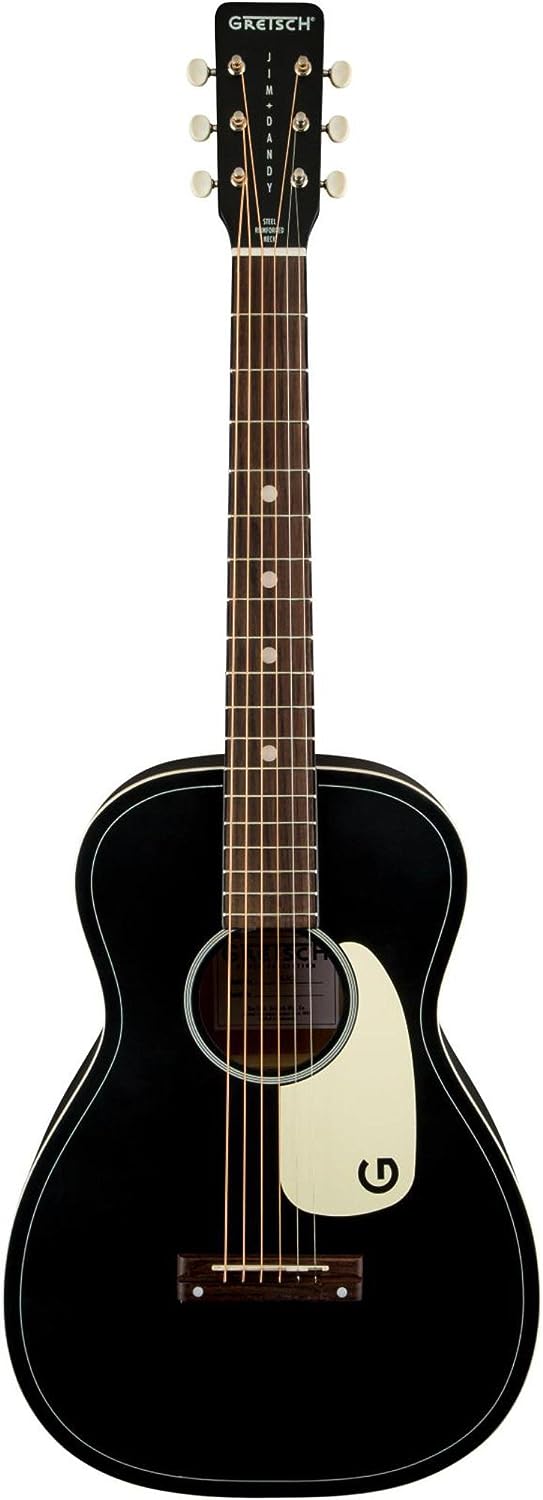
The Gretsch Guitars G9520 Jim Dandy Flat Top Acoustic Guitar comes in a sleek black finish, reimagining the classic “Rex” parlor guitars from a bygone era.
This small-bodied guitar is anything but small on tone, boasting a truly full sound.
It serves as an excellent choice for both picking and fingerstyle playing.
The body of the guitar is made of Agathis, which helps produce a warm, deep sound.
Its non-cutaway structure contributes to the guitar’s unique tonal characteristics.
Made from both Rosewood and Agathis Wood, the guitar’s top is an integral component in shaping its sound.
Keeping in tune and intonation steady across the neck is the rosewood bridge that houses a synthetic bone saddle.
The “C”-shape nato neck, which joints the body at the 12th fret, is paired with a smooth-playing rosewood fingerboard, making it very comfortable for the player.
The fingerboard further includes vintage-style frets and pearloid dot inlays, a delightful nod to its heritage.
The guitar’s neck also houses a dual-action truss rod which allows any necessary adjustments due to changes in temperature or humidity.
Adding to its vintage appeal is its 1950s style Gretsch 3×3 headstock and open-gear die-cast tuning machines.
Finally, the Nickel-plated hardware and attribute of being a right-hand oriented instrument with six strings complete this guitar’s profile.
Whether you are a beginner or a pro, the Jim Dandy Flat Top offers much inspiration with its vintage tone, powerful bass response, and the comfort it provides while playing.
- My Review
As a guitar enthusiast, my attention was initially captured by the Gretsch Guitars G9520 Jim Dandy Flat Top Acoustic Guitar Black.
The guitar’s parlor body type, constructed of agathis wood, creates a distinctly inviting and warm tone.
However, it’s not just the tonal warmth that wins me over, but the overall acoustics that seem to exude a vibrantly lively response, attributed to the special X-bracing on the Agathis top.
Despite the lack of a cutaway design, my experience playing fingerstyle melodies and picking chords felt unhindered and surprisingly comfortable.
Its slim and easy-to-handle “C”-shape Nato neck, joining the body at the 12th fret, provided a satisfying sense of balance and ease while playing.
Something else to appreciate about this guitar is the use of Rosewood for its top Material Type, Neck Material Type, Body Material, Fretboard Material Type, and even Back Material Type.
Always a favorite among guitar makers, Rosewood enhances the resulting tone with its rich overtones and brilliant clarity.
One characteristic that stood out to me was the vintage-style frets and pearloid dot inlays on a rosewood fingerboard.
This feature not only added wonderfully to the visual aesthetics, but effectively improved my tactile interaction with the instrument as well.
The sound in particular, emanates an authentic, woody resonance full of character, along with a full-sounding bass that transcends its small body.
Nickel-plated hardware, white body binding, and rosette along with its sleek black finish lends to the elegantly vintage appeal of this guitar, making it not just a musical instrument, but a visual delight as well.
The fact that its strings are made of nickel, the Jim Dandy guitar has an enhanced, bright sound quality that serves as a making point for both beginners and seasoned guitarists alike.
I also noticed that the Gretsch Guitars G9520 Jim Dandy Flat Top Acoustic Guitar, while compact and portable – ideal for travel – doesn’t compromise on delivering full-toned quality sound.
On a side note, the tuning stability could be improved, although this is not something that can’t be managed with a high-quality nut replacement.
All said, this is a robust and versatile instrument that I’d be eager to play again and confidently recommend to anyone looking for a complete musical package in a compact size.
- Pros:
- Excellent tone and sound.
- Perfect as a travel guitar.
- Appealing visual design.
- Cons:
- Possible tuning instability.
- No cutaway design.
- May sound less impressive to some.
My final verdict is that the Gretsch Guitars G9520 Jim Dandy Flat Top Acoustic Guitar is a remarkably impressive piece.
Its classic Gretsch acoustic sound and woody vintage tone make it a great addition to any guitar collection, regardless of the player’s skill level.
The guitar’s small body does not compromise on tone or playability, making it perfect for both picked and fingerstyle playing.
Moreover, it is comfortable to play and it is appropriate for varying conditions due to its dual-action truss rod.
The Jim Dandy Flat Top is not just a guitar; it’s a work of art with incredible functionality.
Ovation CS24-1 Celebrity Standard Acoustic-Electric Guitar
High-quality sound with exceptional tonal complexity.
The Celebrity Standard CS24-1 guitar offers first-rate sound and style, featuring a mid-depth Lyrachord cutaway body with scalloped “X” bracing for enhanced resonance. The guitar incorporates a beautiful sunburst finish, rosewood components, and an effortlessly playable neck. To ensure superb live sound, it also includes an Ovation Slimline pickup and an OP-4BT preamp system.
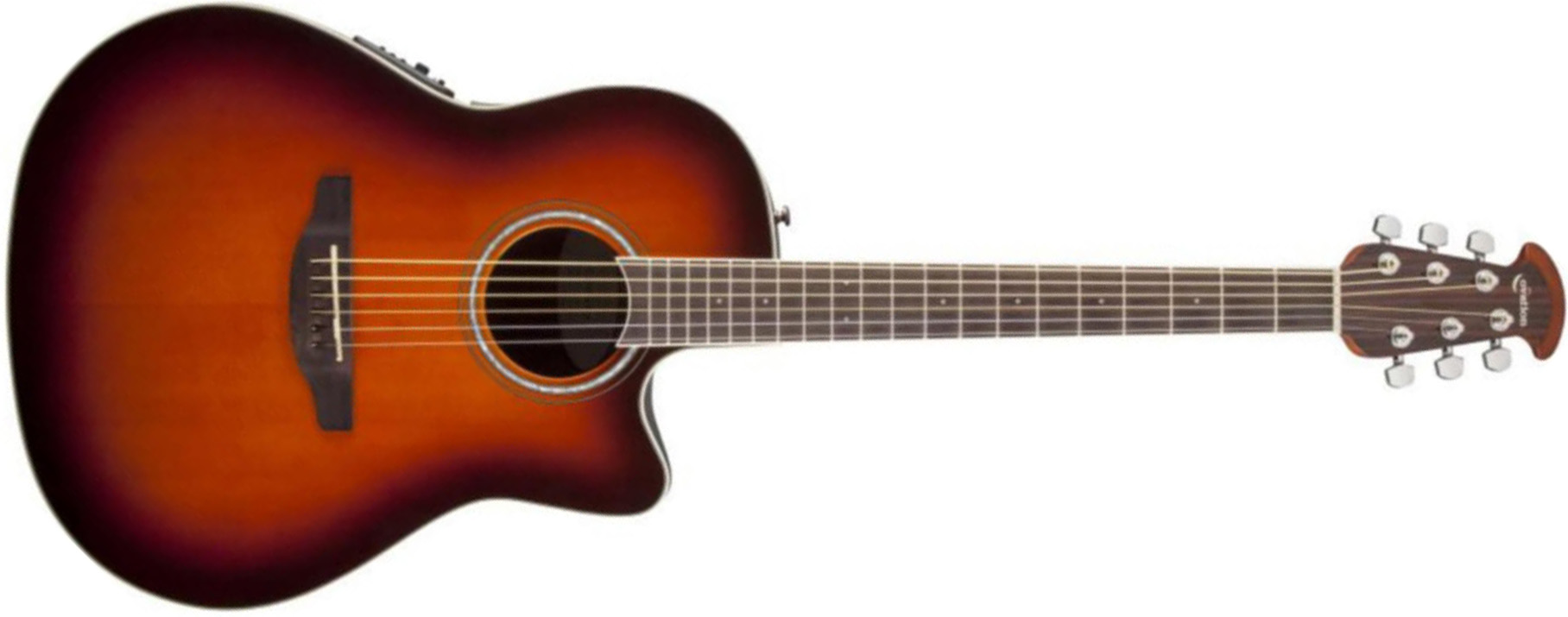
The guitar we’re discussing here is from Ovation’s Celebrity Standard series, particularly the CS24-1 model, which has a mid-depth Lyrachord cutaway body design.
This instrument displays a beautiful Sunburst color scheme that further enhances its appeal.
One of the key features of this guitar is the quartersawn scalloped “X” bracing, which has been redesigned from earlier versions for improved response, power, and natural tone.
Offering a body that vibrates with full projection and remarkable note clarity, you’ll also notice nuanced tonal complexity that makes it unique.
The waving design of the spruce top is well-accentuated by a luxurious pearloid rosette, ivory white binding, with a beautiful two-tone Sunburst finish.
The guitar does not just look good, but is also designed to be easy to play with its rosewood fretboard featuring 20 frets and pearloid microdot inlays.
Plugged in, you’ll get amazing live sound from an Ovation Slimline pickup and the OP-4BT preamp system, which also features three-band EQ, volume/gain control, an onboard tuner, and a low-battery light.
This guitar’s neck also pulls off a subtle satin finish and rosewood-veneer headstock.
All of these elements together make this guitar a formidable option for anyone looking to venture the world of Ovation guitars.
- My Review
Diving straight into the review, I feel compelled to acknowledge the impressive mid-depth Lyrachord cutaway body of the Ovation CS24-1 Celebrity Standard guitar.
It carries a touch of class cultivated by the solid spruce top that comes adorned in a glossy, two-color Sunburst finish.
What makes this particular guitar distinguishable from its counterparts is the quartersawn scalloped “X” bracing, a design element embraced by Ovation after meticulous comparative studies of different bracing patterns.
The result manifests in the outstanding acoustic rendition that the guitar produces when played.
An element worth mentioning is the abundance of rosewood used in this instrument’s construction – from the body and the top material type to even the fretboard and the neck.
From my experience, I can tell you that the guitar bridge system is fixed and the number of its strings is 6.
It’s oriented for right-handers, which I found suitable for comfortable and easy usage.
When it comes to sound quality, the Ovation CS24-1 Celebrity Standard certainly doesn’t fall short.
The smooth blend of the natural spruce top with the rosewood body contributes to creating a robust sound projection, delivering clear notes and a well-balanced tonal complexity.
I also noticed the effortless playability facilitated by the satin-finished neck in tandem with the bound rosewood fretboard.
Another fascinating aspect I appreciated was the onboard Ovation Slimline pickup partnered with the OP-4BT preamp system.
This power duo enhances the guitar’s live sound quality considerably providing controls for volume, gain, and a three-band EQ, not to mention the convenient and precise tuner.
I must also highlight a minor quality control issue I experienced with the strings’ nuts and washers that required a quick fix on my arrival.
Despite this, it was a minor hiccup that was quickly resolved with a bit of patience and a few minutes of my time.
For those who enjoy the lively resonance distinct to Ovation guitars and aren’t deterred by minor assembly quirks, the Ovation CS24-1 Celebrity Standard guitar can indeed be considered a violin of choice.
- Pros:
- Excellent built-in tuner.
- Effortless playability.
- Distinct sound quality.
- Cons:
- Possible slip off when sitting down.
- May arrive with loose components.
- Slight variance in sound.
My final verdict is that the Ovation CS24-1 Celebrity Standard Mid-Depth Sunburst Acoustic/Electric Guitar is by far one of the best guitars in its price range.
Providing a beautiful resonance associated with the Ovation brand, this guitar exhibits remarkable note clarity and balance, all while delivering powerful, nuanced tonal complexity.
The high quality materials used, particularly the extensive use of rosewood, contribute to its excellent sound and comfortable playability.
The added features such as the onboard tuner, three-band EQ and volume/gain control offer versatile options for fine-tuning your sound, making it ideal for both stage performances and studio work.
This guitar is certainly a worthy choice for both beginners and seasoned players looking for value and versatility in an acoustic-electric guitar.
Journey Instruments OF660M Carbon Fiber Travel Guitar
Portable, durable carbon fiber travel guitar.
This travel guitar features a patented collapsible system for swift assembly and disassembly, all in 20 seconds. Made of sturdy carbon fiber, it ensures longer sustain and comes with a TSA compliant backpack case for secure overhead storage. Endeared with a lifetime warranty, it specifically caters to the needs of traveling musicians.
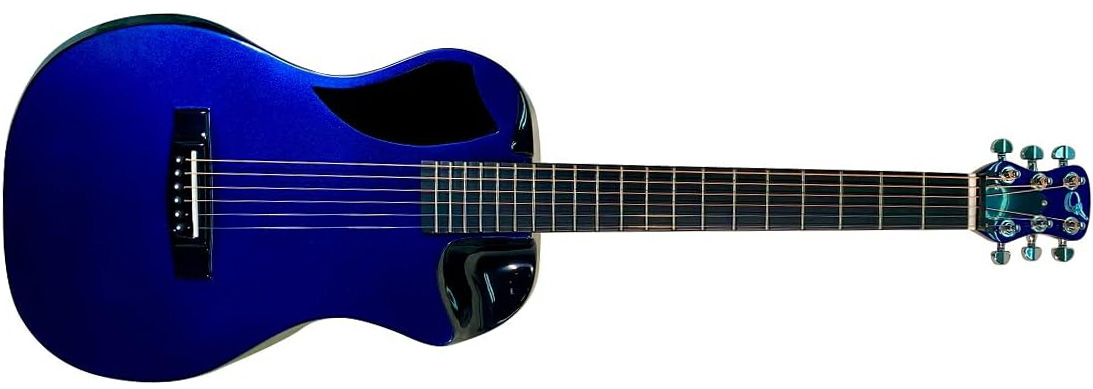
Are you a musician that likes to travel or simply looking for a reliable, portable guitar? May I suggest you consider the OF660M Travel Guitar by Journey Instruments. This is not your typical guitar, it’s designed with the traveling musician in mind.
One of the stand-out features is its patented collapsible neck.
This innovative mechanism allows you to assemble and disassemble your instrument in a matter of seconds, making it possible to keep this full-sized guitar with you wherever you go.
This instrument is also crafted from high-quality carbon fiber fabrics.
The utilization of this material across all core components of the guitar not only provides stability and durability, but also enhances the energy transfer and sustain of each note played, enabling top-notch performances no matter the stage.
For its mobility convenience, it comes with a TSA compliant backpack.
This is definitely a dream for backpackers as its compact size, even when in the case, allows it to fit snugly in most airplane overhead compartments.
The company takes pride in their lifetime guarantee they offer for the stainless steel locking system that secures the neck. This guarantee gives you peace of mind that your instrument will withstand your travels.
Journey Instruments has made a name for itself specialising in travel guitars, consistently prioritising the needs and feedback of musicians for a tailored experience. This Matte Black OF660M Travel Guitar embodies this ethos perfectly.
As for its specifications, the guitar boasts carbon fiber construction on the top, body, back, neck, and fretboard.
The string material is phosphor bronze with an under-saddle passive 3-piezo transducer pickup configuration. And for those who play right-handed, this is the guitar for you.
- My Review
Upon first handling the Journey Instruments Carbon Fiber Travel Guitar – OF660M, I noticed its sturdy and tactile build. It’s crafted with quality pre-impregnated carbon fiber fabrics, these core components lend stability and durability to the instrument.
It is surprisingly heavier than expected though. Unlike the perception that carbon fiber is lightweight, in comparison with traditional acoustic guitar materials, it tends to lean toward the heavier side.
As I began to strum, the guitar emitted an incredible sound. The bass was deep, resonant and notably loud. On the other hand, the trebles could get extremely bright, almost piercing at times.
While on the subject of playability, I found that it takes some getting used to.
Granted, the low-action bridge induced a bit of buzzing if a note was played too close to the fret. However, the sound gets significantly more balanced with notes played in the middle of the fret.
Then came the test of comfort. Despite having some difficulty maintaining proper posture while playing on my right leg, I found a classical style to be in between the legs.
This made extended play sessions easier. Standing up and using the strap worked well too, though it might require periodic shifts in position.
The journey Instruments guitar came with locking tuners, a feature I’m not accustomed to.
At first, they seemed a bit coarse, as I often felt like I was overturning the tuner. However, with a bit of practice, it became easier to handle.
One excellent feature that drew me in was the patented collapsible neck system which facilitates easy assembly and disassembly in approximately 20 seconds.
It also allows the guitar to fit neatly into the premium TSA-complaint carry-on backpack. This feature indeed transformed it into a backpacker’s dream.
The guitar didn’t fall short in quality.
The frets were smooth and there were no uncomfortable protrusions. I also appreciate the even spacing of strings near the bridge, thanks to the slightly rotated pegs.
The confidence the company has in their product is made apparent by their lifetime warranty on the neck locking system.
It truly reflects their commitment to customer satisfaction and the faith they have in their product’s durability and performance.
Lastly, I’m truly amazed by how this instrument catered to the needs of travelling musicians.
Journey Instruments has indeed made no compromises in curating a tailored experience.
- Pros:
- Compact and easy to assemble.
- Good sound and volume production.
- Stable and durable carbon fiber construction.
- Cons:
- Potential issues with the electronic pickup.
- Intonation issues reported by some users.
- Some users found it heavier than expected.
My final verdict is that the Journey Instruments Carbon Fiber Travel Guitar is an exceptional choice for traveling musicians.
The patented collapsible system not only makes it easy to transport but also ensures that its structural integrity is maintained.
Additionally, the use of carbon fiber in every core component significantly contributes to its durability and high performance.
The inclusion of a TSA compliant carry-on backpack adds convenience and practicality for air travel.
The lifetime warranty and the high level of customer service from Journey Instruments make this investment worthwhile.
Cole Clark AN2EC Acoustic-Electric Guitar
Sustainably-sourced, versatile sound, Australian-made guitar.
This guitar boasts a patented 3-way pickup system for versatile sound, and is made from sustainably sourced Australian timbers, with a satin finish. A Spanish heel neck joint and internally carved top contribute to the unique construction. It includes a 9V battery, pickguard, maintenance guide, and case.
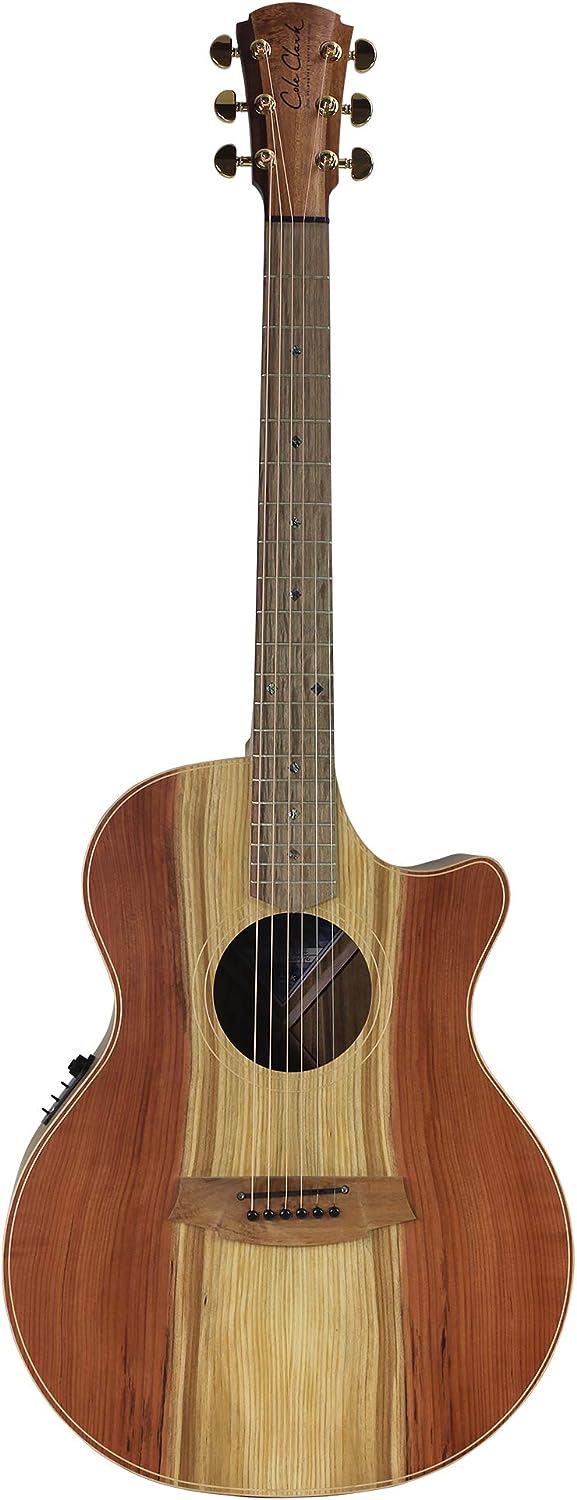
With a unique patented 3-Way Pickup system, the Cole Clark Guitars 6 String Music Accessory, coloured in sleek black and designed for right-handed users, ensures a natural and flexible soundscape when plugged in.
The materials utilized for the guitar’s construction are 100% sustainable – Solid Australian timbers, lending to an eco-conscious ethos.
The guitar build features a Satin Nitrocellulose finish, a hallmark of premium quality.
A variety of singular crafting techniques such as the Spanish Heel Neck Joint, Internally Carved Top and Back Timbers, and use of the Plek Machine for precision in terms of playability and intonation, raise the instrument’s functionality and aesthetic to new levels.
The guitar’s top features Redwood timbers, known for their harmonically complex and very open tones, an addition that audiophiles and music enthusiasts would surely appreciate.
A 9V battery, pickguard, maintenance guide, and a case accompanies the guitar, ensuring you have all the essentials to maintain and protect your musical investment.
The brand at the helm, Cole Clark Guitars, hailing from Melbourne, Australia, speaks of renowned quality in guitar craftsmanship.
The inclusion of a Piezo guitar pickup configuration, use of Phosphor Bronze strings, a fixed guitar bridge system and a total of six strings all culminate into a grand auditorium acoustic-electric guitar from the Cole Clark Guitars Angel 2 Series.
- My Review
As a seasoned guitarist, I was particularly drawn to the unique construction techniques of this Cole Clark Guitar.
I was thrilled to experience the versatility that this right-handed, 6-string guitar offers, thanks to its patented 3-way pickup system.
There’s no denying that the commitment to sustainability is a standout feature, with the promising use of 100% sustainably-sourced solid Australian timbers.
I have to give credit to the positively fine workmanship that has gone into the satin nitrocellulose finish.
Also noteworthy is the Spanish heel neck joint and internally carved top and back timbers; they are a testimony to the impeccable construction of this guitar.
The redwood top timbers are a visual delight and add a harmonically complex and open tone to every strum.
I love that this beautiful guitar is meticulously crafted in Melbourne, Australia.
There’s barely a minute detail overlooked, including the provisions for a 9V battery, pickguard, maintenance guide, and a case.
A closer look at the specifications reveals a distinct selection of materials that are optimally chosen to enhance sound quality and user convenience.
The body and back materials, Rosewood and Blackwood respectively, do add an element of style and quality.
The piezo pickup configuration intrigued me; it adds a dynamic range to the music.
The use of phosphor bronze for the strings, significantly contributes to the overall acoustic sound quality.
It’s a right-handed guitar, perfectly designed to be a musician’s companion.
The Fixed bridge system provides the ideal support for all strings.
Nevertheless, I felt that a bit more information could be provided on exactly how the 3-way pickup system integrates into the sound output and customization of the guitar.
As a stylish, highly functional and sustainable guitar, the Cole Clark Guitar is a well-rounded musical accessory for all guitar enthusiasts.
- Pros:
- Distinctive 3-Way Pickup System.
- Sustainably-Sourced Solid Australian Timbers.
- Included Accessories (Battery, Pickguard, Case).
- Cons:
- Specific Hand Orientation (Right).
- Potentially High Price for some.
My final verdict is that the Cole Clark Guitars 6 String Music Accessory is an excellent choice for both professionals and casual musicians.
The patented 3-way pickup system offers a versatile and natural plugged-in sound, a clear edge over other models.
The use of sustainably-sourced Australian timbers and unique construction techniques shows the excellent approach to quality and reliability.
Additionally, every purchase includes helpful extras such as a 9V battery, a pickguard, a maintenance guide, and a case, providing great value for the money.
The guitar represents a solid combination of aesthetic appeal and superb performance, making it highly recommended.
Martin LXK2 Little Martin Acoustic Guitar
Perfect for travel and beginner guitar students.
This acoustic guitar is tailor-made for beginners, smaller hands, and is convenient for travel, encapsulated in a heavily padded gig bag. It boasts a wood-pattern HPL top with Sitka spruce bracing and a Stratabond neck. Its features also include a fixed bridge system, Gotoh nickel-plated tuners, and a 23-inch scale length.
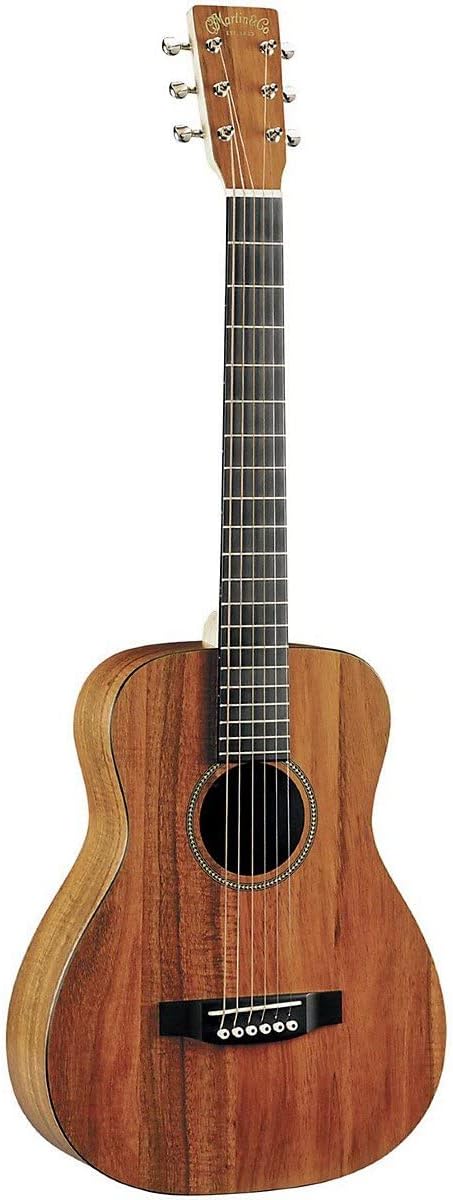
The Martin LXK2 Little Martin is a compact-sized guitar, designed with eye-catching Koa pattern HPL top. This instrument, with its size and design, works great for students starting out, practising musicians or even if you’re just constantly on the move.
What sets it apart is, it features “1-style” Sitka spruce bracing, which enhances its sound projection and offers an excellent resonance.
Importantly, it comes with Martin’s patented neck mortise, designed to provide an unmatched stability.
Adding to its elegance, the guitar showcases the strong> C.F. Martin script logo on the headstock.
The guitar is from the trustworthy brand, MARTIN, and it has been crafted with a variety of quality materials.
The top of the guitar features a Koa material type while the body is made of Sitka Spruce.
The back part is made of Koa as well and the neck features Natural Stratabond.
Other than that, the fretboard is constructed from Richlite and the strings are made of Nickel.
This right-handed guitar comes with a Fixed Guitar Bridge System and offers a 23 Inches Scale Length.
In addition to the guitar itself, it comes with a heavily padded gig bag to carry around. There is also an option to choose different colors if you would like to customize it to your liking.
- My Review
After having had the opportunity to spend significant time with the Martin LXK2 Little Martin Koa Pattern HPL Top, a few key features have solidly stood out to me.
First and foremost, the tonal quality of this compact guitar is quite impressive, far surpassing what one would anticipate from an instrument its size.
Boasting a “1-style” Sitka spruce bracing, I found the emitted sound excellent for various styles of play, from fingerstyle to strumming.
As for the C.F. Martin script logo on the headstock, it lends an authentic and classy touch to the overall appearance of the guitar.
Despite its relatively small body, the strength and durability of this instrument has me won over with its resistance to temperature changes and overall robust build.
Moving to the size and portability, it fits the mold perfectly for those seeking a smaller, travel-friendly guitar that maintains a rich sound.
This quality combined with the inclusion of a padded gig bag make it an ideal companion for road trips, campfire sessions, or simply carrying it around.
However, it’s worth pointing, the guitar tuners on this model felt slightly inconsistent, mainly on the low E string which required more effort to tune up.
Additionally, the guitar did display high action towards the body, while this does help it project notes higher on the fretboard, it was something I had to adjust to.
Regarding the laminate finish, although it was visually pleasing, I observed a distinct difference in the quality and texture compared to more expensive models.
The 23-inch scale length of the guitar facilitates ease of playing for beginners or those with smaller hands, a trait worth appreciating in a practice guitar.
Though the sound quality may not match up to its full-sized counterparts, the Martin LXK2 definitely produces a warm and pleasant tone.
What matters is understanding that its purpose serves those needing a guitar that’s compact, durable, and yet maintains a satisfactory level of sound quality.
The overall value you’re getting with a trusted brand like Martin in a travel sized package makes this a model worth considering.
- Pros:
- Excellent tone for its size.
- Great for travel and beginners.
- Durable and robust material.
- Cons:
- Pattern on top and back sloppy.
- Sound less impressive with strumming.
- Potential for wood swelling issues.
My final verdict is that the Martin LXK2 Little Martin Koa Pattern HPL Top with Padded Gigbag is an outstanding option worth considering.
This guitar is especially convenient for travel, practice, and beginning students, offering a high-quality experience unlike any other.
The small, modified 0-14 Martin body, with “1-style” Sitka spruce bracing, contributes to its great sound and easy playability.
The addition of Gotoh nickel-plated tuners and Martin’s patented neck mortise shows the level of detail and thought put into this guitar’s design.
The Martin LXK2 Little Martin Koa Pattern HPL Top with Padded Gigbag showcases Martin’s commitment to quality and innovation in the world of acoustic guitars.
Yamaha JR1 FG Junior Acoustic Guitar
Compact, authentic tone, perfect for young players.
This is a 3/4-sized guitar, perfect for young musicians or individuals with smaller hands, modeled after the renowned Yamaha FG Series. With Yamaha craftsmanship and a spruce top, it offers an authentic acoustic tone, and is also great for travel due to its compact size. It comes with a gig bag for easy storage and transport.
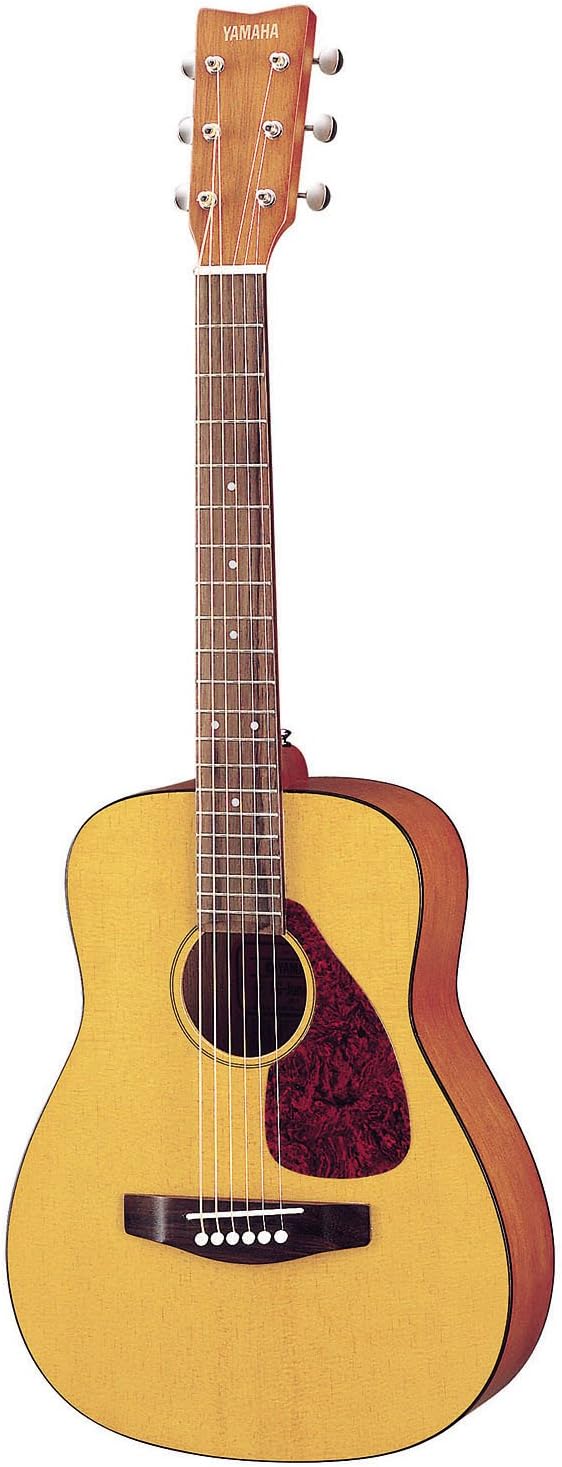
Modeled on the respected Yamaha FG Series, the FG Junior is a guitar with a 3/4 size.
Optimal for youngsters or individuals with compact hands, this instrument features a diminished body and shorter neck.
Yamaha’s exceptional craftsmanship paired with a spruce top endows this small-sized guitar with a genuine acoustic feel.
It is highly suitable as a travel guitar when you’re short on space.
The package also includes a gig bag for convenient transport and safekeeping of the instrument. The saddle of the guitar is made of Urea.
This guitar is from the globally recognized brand Yamaha and comes in a natural color.
The top layer of the guitar is made from Spruce, and the body is composed of laminated-wood.
Its back is crafted from Mahogany, and the neck from Nato, giving it a robust and durable build.
The fretboard material type is Rosewood and it has a singular guitar pickup configuration.
The guitar uses Bronze strings and is designed to be ambidextrous.
The JR1, like all Yamaha guitars, boasts of a meticulous selection of wood in its construction.
Featuring a spruce top, a nato neck, a rosewood fingerboard, and a meranti body, it offers vibrant tonality and stunning looks.
Complete with chrome hardware and a gig bag, the JR1 makes for an ideal first guitar for a child or a great travel companion.
- My Review
My first impression of Yamaha JR1 FG Junior 3/4 Size Acoustic Guitar leans towards its attention to detail.
This guitar isn’t just another scaled-down version of a full-size guitar, but a carefully designed instrument with the needs of a younger or smaller player in mind.
Its size is perfect for those with smaller hands or for those who seek a comfortable travel guitar.
The provision of a gig bag is an appreciative bonus, taking into consideration the portability aspect of the product.
Upon strumming the strings for the first time, I was taken by the authentic acoustic tones it produced.
The spruce top, known for its excellent response, doesn’t compromise the sound, despite the compact body.
The use of laminated-wood for the body and rosewood for the fretboard ensure a rich and warm tone.
I wasn’t particularly happy about the urea saddle, as it might affect its intonation in the long run.
The bronze strings add to its rich tonality and vibrations while maintaining a bright sound.
However, I’ve noticed a few minor finishing issues with the guitar.
In some areas, the binding has small bubbles and debris entangled, leaving a less than smooth surface.
Although these are mostly aesthetic concerns, one may expect a finer finish from Yamaha.
The guitar strings did need some extra tuning, which is fine, but they would not stay in tune for long.
This could affect the performance of someone advancing from a beginner’s level.
On the brighter side, the low action level is friendly towards tender fingertips, and this doesn’t cause unwanted buzzing.
Despite some concerns, I’m leaning towards a positive evaluation of this guitar
If you’re a beginner, or have a smaller stature, it’s tough to find a similar-sized guitar with a comparable quality and tone.
While it’s not perfect, the Yamaha JR1 FG Junior’s overall value for money makes it a worthwhile consideration.
- Pros:
- Excellent for beginners and smaller players.
- Great sound and Yamaha craftsmanship.
- Includes gig bag for easy transport.
- Cons:
- Potential issues with tuning stability.
- Some users found string-to-string closeness.
- Construction quality may vary.
My final verdict is that the Yamaha JR1 FG Junior 3/4 Size Acoustic Guitar is an excellent choice for young players or those with smaller hands.
Its compact size and Yamaha craftsmanship combine to provide an authentic acoustic tone that is truly impressive for a guitar of this size.
The fact that it comes with a gig bag makes it a practical choice for individuals who need a reliable travel guitar.
Furthermore, the quality materials used in its construction ensure its durability and longevity.
It is a high-quality instrument that offers great value for money.
Fender Malibu Player Acoustic Guitar
Versatile, comfortable acoustic-electric guitar with superior resonance.
A compact, short-scale acoustic-electric guitar, the Malibu Player is designed with a comfortable feel to inspire new chords and melodies. Constructed with a solid spruce top, a mahogany neck, back, and sides, the guitar generates a balanced, articulate sound, perfect for the stage or studio. Enhanced with a Fishman preamp system, this guitar reproduces natural sound when amplified.
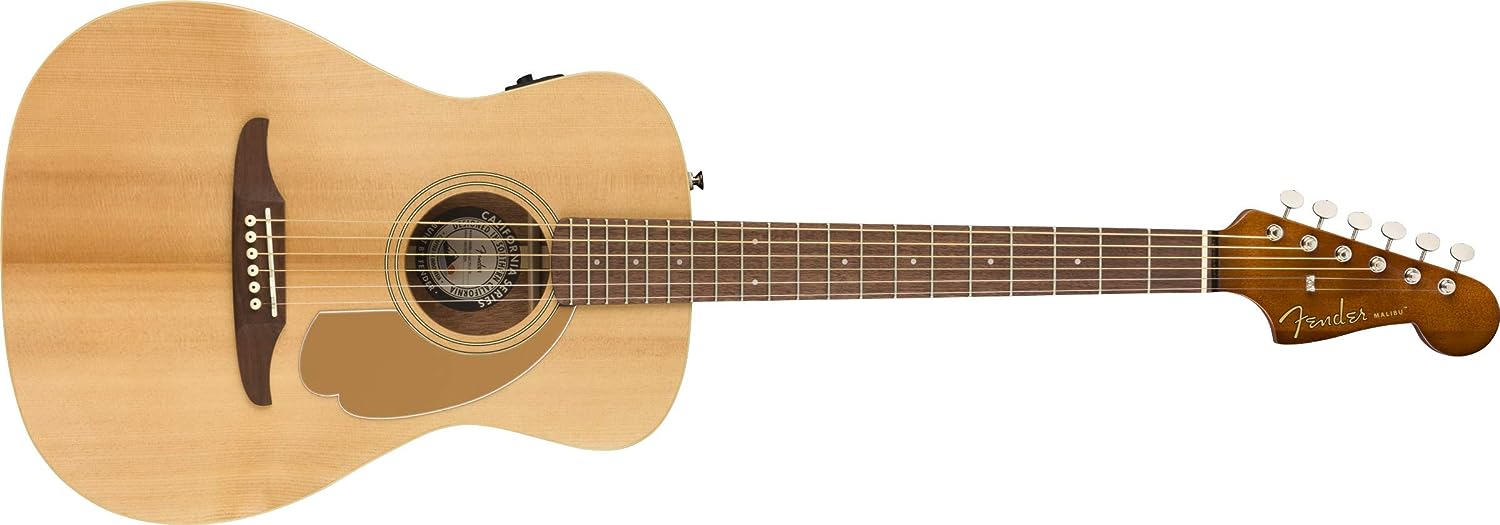
If you’re looking to stand out from the crowd, consider the Fender Malibu Player Acoustic Guitar.
One of its significant characteristics is the distinctive Malibu body shape, exclusively from Fender.
The guitar is made with a combination of solid spruce and mahogany wood, guaranteeing resilience and robustness.
Besides that, the guitar showcases a Fender-unique CD-1 Fishman pickup/preamp system promising an exceptional sound quality.
This Fender Malibu’s neck is made of mahogany and shaped in a convenient “C” profile. It’s also fitted with a walnut fingerboard and bridge.
It holds a 6-in-line headstock, which might be more familiar to those accustomed to playing Fender’s electric guitars.
The color labeled for this guitar is natural, providing it with a classic wooden aesthetic.
The top and back material types include walnut wood and mahogany wood, contributing to the overall tone and durability.
The guitar features a Piezo pickup configuration, providing it with a clear, bright sound.
The strings used in this guitar are of phosphor bronze material, known for their traditional warm, bright, and balanced tone.
The Fender Malibu Player Acoustic Guitar is designed for right-handed individuals, making it suitable for a broad range of musicians.
Regardless of your preferred playing style, this acoustic-electric guitar ensures a comfortable feel and unique aesthetics, hence promoting a greater urge to experiment with different chords and melodies.
- My Review
From my first observation, the Fender Malibu Player is not only rich in aesthetics but also presents a much-needed break from conventional guitar designs.
Embracing a compact small-body design, I find it offers the convenience and ease of handling, especially for those who appreciate shorter scale lengths.
The solid spruce top imparts a lively look to the guitar while serving as an essential element in enhancing the instrument’s tonal quality.
My exploration of its sound characteristics revealed an articulate, seamless blend of highs, mids, and lows, achieved by thoughtfully coupling the spruce top with mahogany back and sides.
When it comes to the neck profile, I was excited to discover the “C”-shaped mahogany neck, which was unbelievably comfortable and smooth to the touch, catering remarkably well to varied playing styles.
Further, the Fishman pickup/preamp system exceeded my expectations, allowing me to replicate the natural acoustic sound even when plugged into an amplifier, a feature I find invaluable for professional gigging or recording.
Adding to its appeal, the Fender-exclusive Malibu body shape and eye-catching 6-inline headstock makes this guitar visually irresistible too.
The mix of phosphor bronze string material and a walnut fingerboard and bridge results in a composite sound, layered with warmth and richness, magnifying the sound potential of the guitar.
Upon interacting with the preamp system, I realized the tonal versatility it brings to the table, offering a range of sound effects designed for the exploratory player.
Even though the sound volume might not match that of a dreadnought, I’m inclined to take this as a deliberate design choice by Fender, serving well for those seeking a softer, more personal sound.
One cannot overlook the GraphTech NuBone nut and saddle that contribute to the improved sustain and tonal characteristics of the guitar.
Despite all its striking features, I must highlight that the guitar’s right-hand orientation could possibly limit its appeal to left-handed players.
Having said that, the Fender Malibu Player truly reflects Fender’s commitment to quality and delivers an exceptional acoustic-electric experience with its distinct aesthetics and unrivaled sound quality.
It’s the ideal companion for players keen on standing out, whether they’re on stage, in their bedroom, or in the recording studio.
In the end, every detail seems thoughtfully designed to provide a unique guitar that’s as much a pleasure to hear as it is to play.
- Pros:
- Great sound when plugged in.
- Optimal resonance and balanced sound.
- Comfortable slim-taper “C”-shaped profile.
- Cons:
- Not as loud as other models.
My final verdict is that the Fender Malibu Player Acoustic Guitar is an excellent choice for any musician looking for a high-quality acoustic guitar.
The guitar offers not only a bold and balanced sound, but also a comfortable feel that inspires to explore new chords and melodies.
Its solid spruce top, mahogany back, sides and neck, and special attention to resonance and sound reproduction make it a strong competitor on the market.
Whether for stage or studio use, the Malibu Player is uniquely stylish and resonates with those destined to stand out.
This guitar’s playability, superior construction, and unique aesthetics make it a worthwhile investment.
What to Look for When Buying Acoustic Guitars for Camping?
When gearing up for the great outdoors, your guitar should be an essential partner on your journey.
Selecting the right acoustic guitar for camping involves considering various factors that ensure durability, portability, and sound quality.
Let’s explore these considerations to help you make the best decision.
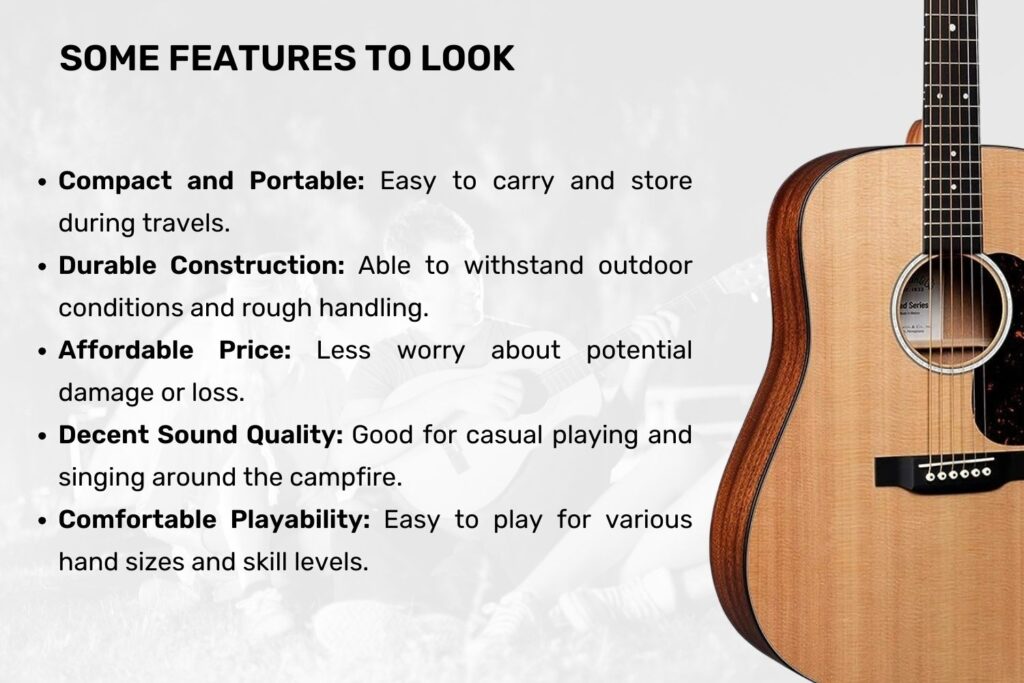
The material of the guitar is something any camper should take into account.
While solid wood guitars produce the best sound quality, they are also susceptible to fluctuations in humidity and temperature.
For camping, consider a guitar made of laminated wood or stronger, more resistant materials like high-pressure laminate (HPL) or carbon fiber.
Durability is another key factor to think about.
Camping involves much moving around and exposure to the elements, so you need a guitar that can withstand rough handling and inclement weather.
A guitar built with strong construction and finishing for rugged situations is ideal.
In line with durability, the size of your guitar is crucial.
Smaller, travel-sized guitars offer great portability without sacrificing too much on sound quality.
Remember that carrying around a full-sized guitar might become a burden in a camping environment.
Next, consider the sound of the guitar.
The travel-sized guitars might be compact and convenient, but they also have smaller soundboxes, which can affect the volume and tone.
Find a balance between size and sound that fits your personal preferences.
Weight is another significant factor.
The lighter your load, the more comfortably you can travel.
However, make sure not to compromise on sound quality and durability just for a lighter guitar.
Again, it’s all about balance.
Moreover, guitar care and maintenance should be taken into account.
Dust, dirt, rain, and humidity can damage your guitar.
So, it’s crucial to choose a model designed to handle these conditions.
Some guitars come with built-in protective features, such as a moisture-resistant coating.
Another noteworthy consideration is your budget.
There is no shortage of high-end guitars that promise superior quality and durability.
However, it might be wise to invest in a budget-friendly guitar for camping to lessen the heartbreak in case it gets damaged.
Last, but certainly not least, consider your skill level.
If you are a beginner, you might be more comfortable with a guitar with a thinner neck and lower action.
More experienced players may prefer guitars with higher action and a larger fretboard.
To choose the best acoustic guitar for camping, consider the guitar’s material, durability, size, sound, weight, protective features, price, and suitability to your skill level.
It’s a delicate balance, but with careful deliberation, you can find the perfect acoustic guitar for your camping escapades.
How Do Weather Conditions Affect Acoustic Guitars?
Now, let’s discuss how the changes in weather conditions can have a significant impact on an acoustic guitar.
One of the key elements you need to be aware of is humidity.
High humidity can cause the wood in the guitar to absorb moisture and swell, which in turn can lead to issues like raised action, fret buzz, or even serious structural damage such as deck deforming.
On the contrary, low humidity can lead to problems like cracks, loose braces or buzzes in the guitar.
Therefore, maintaining an optimal level of moisture for your guitar is crucial, especially when you are camping since the changes in environment conditions can be abrupt.
Aside from humidity, temperature variations can also adversely affect your acoustic guitar.
High temperatures, for example, can cause the guitar glue to soften and potentially lead to the instrument falling apart.
Moreover, exposure to the direct sunlight for an extended period can result in damage to the guitar’s finish.
On the other hand, low temperatures can result in the wood contracting and potentially cracking, especially if the change in temperature is abrupt.
Another critical aspect to consider is the effect of the change in altitude often experienced during camping expeditions.
The change in air pressure that accompanies a change in altitude can cause stress to the wood, leading to possible warping or cracking.
No matter the weather condition, it’s advisable to keep your acoustic guitar in its case when not in use to avoid sudden weather changes.
Consider also keeping a humidity meter in your guitar case to track moisture levels and take necessary actions when needed.
It’s also important to avoid keeping your guitar near heating or cooling elements, as they can excessively dry or moisten the guitar, respectively.
As a camper and a guitarist, it’s worth investing in a decent hard-shell case for your guitar, which can offer your instrument the protection it needs from sudden weather variations.
Understanding how weather conditions affect your guitar isn’t just about preserving the playability and quality of your instrument, it’s about prolonging its life and ensuring it continues to sound good for a long time.
Remember, a well-cared-for guitar is a guitar that plays well and sounds better, and isn’t that every guitarist’s wish?
How to Care for Your Camping Acoustic Guitar?
When you decide to take your acoustic guitar camping, certain steps need to be taken to protect it from the environmental elements often encountered outdoors.
First and foremost, it’s essential to have a good quality guitar case.

A hard-shell case can provide the utmost protection, shielding the guitar from shock, moisture, and dust.
However, this type of case can be heavy and less-ideal for long hikes or travels, therefore a well-padded gig bag might be a more convenient option to consider.
When you reach your camping location, avoid exposing the guitar to direct sunlight as this can cause the wood to warp or crack.
Find a shaded spot, if possible, and always keep the guitar in its case when not in use.
Night-time camping conditions can also greatly affect your guitar’s wellbeing.
A rapid drop in temperature can cause the wood to contract, which could potentially lead to cracking or other structural damage.
To prevent this, you can loosen the strings overnight to relieve tension on the neck of the guitar.
The optimal humidity range for acoustic guitars is between 40% and 60%.
If the weather forecast predicts a rainy day or a significant drop in humidity, it would be wise to pack a small dehumidifier or humidifier box, depending on the situation.
These simple but essential maintenance tools can be placed in the guitar case to maintain a consistent humidity level.
Rainy camping conditions can also increase the risk of water damage to your guitar.
To minimize this risk, try not to play your guitar in the rain no matter how tempting the mood might be.
Water can seep into the wood and warp it, or even worse, cause the glue that holds your guitar together to dissolve over time.
Finally, in the unfortunate situation where your guitar does get wet, make sure you carefully dry off all surfaces with a soft cloth before storing it back in the case.
Regularly cleaning your guitar after playing it is also critical to increase its lifespan.
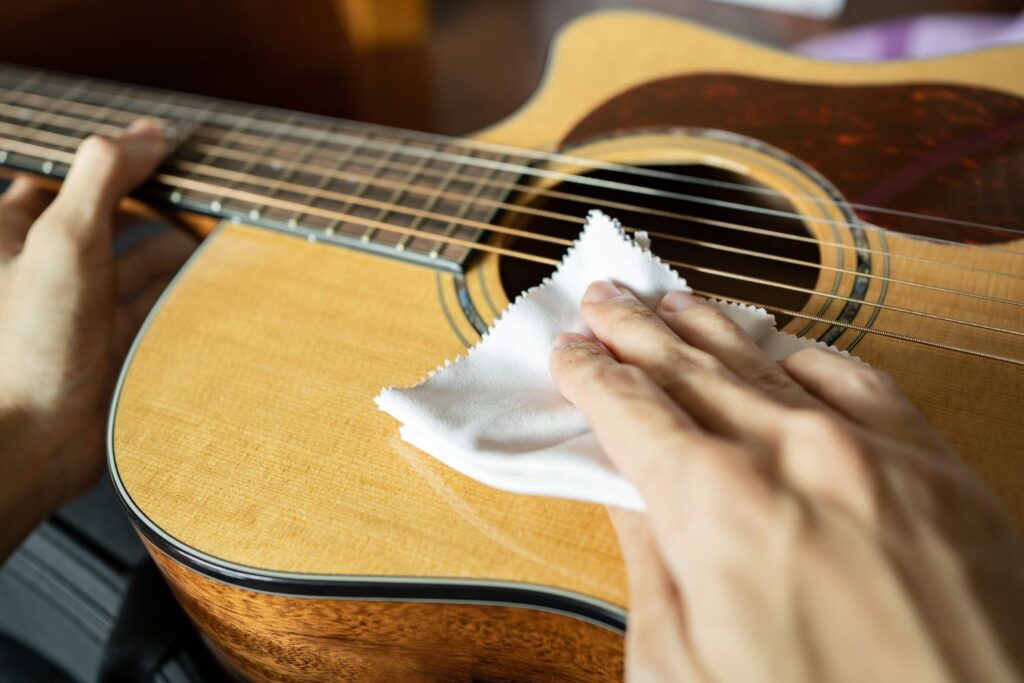
Tears and sweat from your hands can accumulate on the strings and cause them to oxidize faster, so it’s beneficial to wipe down your strings after each play session.
In the end, it all ties back to respecting and understanding the fragility of the guitar and the effects that the outdoors can have on it.
Becoming more observant to those potential threats and modifying your actions accordingly, can extend the life and resonance of your camping acoustic guitar.
What Makes a Guitar Suitable for Camping?
For a musical instrument to be considered suitable for camping, there are a number of unique characteristics it must possess.
The first consideration lies in the portability of the instrument.
This means that the size and weight of the guitar should allow for easy transportation in the great outdoors without causing undue burden on the camper.

You don’t want a giant, heavy guitar that is difficult to carry around on your camping adventures.
Therefore, compact, lighter models are usually the best fit this scenario.
Secondly, the guitar should also have consistent tuning stability that can withstand exposure to the elements.
Unlike controlled environments like homes and studios, the great outdoors subject guitars to temperature changes, humidity, and potentially even rain.
Having an acoustic guitar that maintains its tuning despite these conditions is crucial.
Materials used in construction of the guitar also play a significant role in determining its suitability for camping.
Typically, acoustic guitars made of laminate materials are favored over those made from solid wood for outdoor hobbyists.
This is because laminate materials are generally more resistant to fluctuations in temperature and humidity.
Additionally, sturdy build quality is another essential characteristic to consider.
Rough handling can be common in camping situations.
So, you’ll want a guitar that is robust enough to withstand potential bumps, drops, and shakes during transit.
Another important aspect to consider when choosing a camping guitar is the price point.
Due to the high risk of potential damage, many campers opt for lower-cost models that would be less of a loss if the instrument happens to get ruined.
In this way, the camper can still enjoy the thrill of live music in the great outdoors without worrying too much about their investment.
Moreover, the guitar should have a pleasant and impressive acoustic sound that can resonate well in an outdoor setting.
Camping is especially enjoyed for its ability to bring one closer to nature and its serenity.
Good sound quality can enhance this experience and allow the music to meld perfectly with the natural symphony of the outdoor environment.
While selecting a guitar for camping, it’s important to balance both functionality and music quality.
In doing so, you ensure that the instrument not only stands up to the rigors of outdoors, but also offers an enjoyable musical experience.
Are There Acoustic Guitars Specific for Camping?
Many new and experienced guitarists often wonder if there are acoustic guitars specifically made for camping.
The fact of the matter is there is indeed a subcategory of acoustic guitars that are particularly designed with this purpose in mind.
Guitars manufactured for camping aren’t simply regular acoustic guitars, they include certain features that make them camping-friendly.
Perhaps the most distinctive quality that sets them apart is their durability.
Camping acoustic guitars are built to withstand different outdoor conditions, from extreme heat to excessive cold.
They are made with solid materials which are capable of coping with the extreme wear and tear of outdoor activities.
Another standout feature is their portability.
Since camping involves a great deal of movement and travel, these guitars are designed to be easy to carry around.
They are often light-weight and compact, some even offer the ability to be disassembled for easy storage and transport.
Furthermore, a camping acoustic guitar is generally equipped to handle atmospheric changes better than a regular acoustic guitar.
Rugged conditions such as high humidity, heat, and cold can drastically affect the tuning and tension of the guitar strings.
However, camping acoustic guitars are built with special strings and tuning mechanisms that minimize these effects.
Keep in mind that these unique characteristics does not mean that these guitars are low-quality or offer a poor sound.
In contrary, they can produce the full, rich sound that is expected of acoustic guitars.
They are just engineered with additional features to ensure they can withstand the challenges of the great outdoors.
So, if you’re a camper and love playing guitar by the campfire, a camping acoustic guitar could be an excellent investment.
Its durable construction and portability combined with great sound make it a wonderful companion for your outdoor trips.
Remember, the right guitar can take your camping experience from good to unforgettable.
Is Your Guitar Safe in a Campfire Environment?
Keeping a guitar safe in a campfire environment is a frequent concern for musicians who love to enjoy outdoor activities with their instruments.
Campfires are notorious for their smoke, heat, and ashes, and they can effect the wood of an acoustic guitar in various ways.
Wood, being highly sensitive to temperature fluctuations, tends to expand and contract, which could lead to warping or cracking over time.

Chances of this happening increase when your guitar is repeatedly exposed to the high heat from the campfire and then the cool air away from it.
This exposing to intense fluctuations in temperatures is not ideal for the health of your guitar.
The smoke from campfires can also pose a risk to your guitar.
The soot and other particles in the smoke can accumulate on the strings and the body of your guitar, dulling the finish and decreasing sound quality.
Not to mention, if not cleaned off promptly and appropriately, the residue might cause additional damage to the instrument.
As we are talking about campfire environments, we can’t overlook potential risk of fire accidents.
If not careful, there’s always the risk that an acoustic guitar could catch on fire, especially when left near a campfire.
Therefore, if you do wish to play your guitar by the campfire, you should ensure that it is safely stowed away when not in use, preferably in a hard-shell case.
It is essential to remember that the case itself should be kept away from the fire as well.
Storing your guitar properly is as crucial as being cautious around the fire.
When not in use, the guitar should be stored in a cool, dry place away from the heat source.
Ensure that the storage place is ventilated well enough to prevent any build-up of moisture which could further damage the instrument.
Proper maintenance of your guitar is crucial, especially in a camping environment, so don’t overlook cleaning your instrument carefully.
Use a soft, dry cloth to wipe clean the guitar body and strings to ensure no smoke residue or dust particles are left on it.
Also, you should have your guitar expertly serviced occasionally to keep it in optimal condition.
Remember, while guitars can add a lot to a camping experience, making sure they are well-kept and safe is just as vital to ensure they last a good time.
How to Properly Store Your Camping Acoustic Guitar?
Storing your camping acoustic guitar properly is an essential part of maintaining its quality and sustaining its life.
One of the most critical considerations when storing your guitar is environmental control.
Guitars are made of wood that can warp and crack when exposed to varying temperatures and humidity levels.
Too much moisture can make the wood swell, changing its shape and potentially damaging the guitar.
On the contrary, too little humidity can make the wood dry out and crack.
Therefore, for optimal storage, a humidity level of 45-55% and room temperature is ideal for the guitars.
While camping, these conditions might be challenging to create, but there are several ways to protect your guitar.
You should avoid keeping your guitar directly on the ground as it might be damp or expose it to extreme temperatures.
A hard case can provide excellent protection for your guitar as it’s durable and offers insulation from varying weather conditions.
Consider using a guitar humidifier inside the case to maintain a constant humidity level.
When changing locations while camping, make sure to loosen the guitar strings a little to compensate for changing tension levels due to temperature variations.
Remember to keep the guitar away from campfires as the heat can lead to damages like warping of the guitar body and its neck.
Avoid storing it in direct sunlight for prolonged periods as this can also contribute to such damages.
Packing and unpacking your guitar frequently can lead to potential accidental damages, be gentle and careful while handling your instrument.
Apart from these, regular cleaning and wiping down your guitar from dirt and dust can also ensure its longevity.
Proper storage practices go a long way in ensuring your camping guitar’s durability and sound quality.
Simple steps like these can make your camping acoustic guitar last longer and allow you to enjoy playing it on numerous future camping trips.
Can You Travel Easily with Acoustic Guitars?
One of the key factors to consider when purchasing an acoustic guitar for camping is its portability.
Unlike stationary activities, camping often involves moving from one location to another, and this movement can be tricky when you’re carrying a large, awkwardly shaped object like a guitar
Traveling easily with an acoustic guitar requires the right equipment and a bit of foresight.
Many opt for a travel size guitar, which tends to have a slimmed-down body and shorter neck, making it easier to carry without compromising the instrument’s sound and playability.
If your guitar isn’t specifically designed for travel, consider investing in a high-quality case can make a significant difference in the ease of transportation.
Hardshell cases provide the best protection but can be heavy and bulky to carry, while gig bags are lighter and often include shoulder straps for easier transportation.
One aspect often overlooked when traveling with an acoustic guitar is the climate of the destination.
Guitars are made of wood, a material that reacts significantly to changes in temperature and humidity, which can lead to warping or cracking of the instrument.
This is particularly important when it comes to camping since the guitar is likely to be exposed to outdoor conditions.
To mitigate this, you can condition your guitar for travel by gradually exposing it to the climate of your camping destination.
Convenient ways to do this include storing it in a room with similar conditions or using a guitar humidifier.
You should also consider the physical challenges of camping and plan accordingly.
For instance, if you’ll be hiking a good distance to your camping site, you’ll want to think about the overall weight of your gear and how you’ll distribute it evenly to avoid physical strain.
If your guitar is an essential part of camping but you’re worried about potential damage or the weight contributing to the burden of your backpack, you might want to explore alternatives like collapsible guitars or ukuleles.
They are far easier to carry around and still provide a great source of entertainment around the campfire.
Navigating the world of travel-friendly guitars may take some time and research, yet it is an investment worth making if you enjoy combining your love for music and the outdoors.
Deciding to bring an acoustic guitar on your camping trip can enhance your experience by providing an opportunity to connect with nature in a unique, melodic way.
With careful planning, the right gear, and a bit of knowledge about how to care for your instrument while you’re off the beaten path, you can include your guitar in your wilderness adventures without fear or inconvenience.
Difference Between Regular and Camping Acoustic Guitars?
When you are considering purchasing an acoustic guitar specifically for camping, there are certain differences from regular guitars you should consider.
Acoustic camping guitars are designed with specific features that make them more fitting for the great outdoors.
One notable difference is the material composition of camping guitars versus regular ones.
Often, highly-quality acoustic guitars which are perfect for home or concert performances, are made of delicate woods like spruce or cedar, which can be affected by changing weather conditions.
On the other hand, camping guitars are primarily crafted with more durable materials, such as HPL (High-Pressure Laminate) or specially treated woods, to resist any sudden climate changes, from humidity to temperature swings.
This means that your camping acoustic guitar will be hardier and more resilient to environmental elements.
Another difference is the size and shape of the guitar.
Regular acoustic guitars might be large and bulky, whereas camping guitars tend to be more compact, often referred to as ‘travel’ or ‘mini’ guitars, to allow for easier transportation in backpacks or small spaces in your camping gear.
The size and shape do not necessarily mean that they compromise on the sound, as many camping acoustic guitars are designed to deliver exceptional sound quality.
The weight of the guitar is another aspect that differentiates regular acoustic guitars from camping ones.
Camping acoustic guitars are lightweight in order to be carried around all day without causing exhaustion or strain.
The case that comes with the guitar also tends to vary; regular acoustic guitars usually come with hard cases designed to keep them protected at home or in a studio, whereas the best camping acoustic guitars generally come with a soft, lightweight carry bag that’s more convenient for travelling and outdoor use.
Some premium camping acoustic guitars may even offer a non-traditional body material like carbon fiber, that increases the durability and decreases the weight substantially.
Knowing the difference between regular acoustic guitars and those fit for camping is key in making an informed decision when you’re in the market for a camping acoustic guitar.
Understanding these differences can go a long way in ensuring you have the right blend of sound, convenience, and durability for your camping music experience.
After all, a campfire gathering under the stars would not feel complete without the melody of a good acoustic guitar.
How Important is Weight in a Camping Acoustic Guitar?
When planning a camping trip, one of the factors to consider is the weight of your luggage, and this includes your acoustic guitar.
It is important to understand that weight plays a significant role in determining the comfort and ease of your camping experience.
A lighter guitar will be easier to carry over a distance or when navigating through uneven terrains and dense forests that characterize many camping sites.
Using a heavier acoustic guitar can result in strain or even injury due to the added weight to your camping gear.
Transporting your guitar from place to place during the camping trip can become a strenuous task if the guitar is heavier than necessary.
Therefore, lighter guitars are generally preferred by campers.
However, it’s also essential to consider the guitar’s sound quality as this shouldn’t be compromised for lighter weight.
While lighter guitars are easier to carry, they often produce a quieter sound than their heavier counterparts.
Therefore, it is necessary that you make a balance between weight and sound when choosing a camping acoustic guitar.
You must also consider the weight of the guitar case or gig bag, as you will be carrying this along with the guitar.
These cases, designed to protect your instrument from damage, can add a considerable amount of weight to your load.
Therefore, it’s a good idea to look for a case that offers a balance between protection and weight.
You also need to consider how the weight of the acoustic guitar will affect your camping experience outside of the physical strain.
For instance, if you’re camping in an area where you’ll be hiking or climbing, every extra pound you carry can make those activities more challenging.
While on the other hand, if your camping trip is more relaxed and doesn’t involve much moving around, then a heavier guitar may not be much of a problem.
In these instances, your personal preference in the guitar’s sound might outweigh the concern for its weight.
The weight of an acoustic guitar for camping is a matter of personal preference, physical ability, and the nature of the camping trip.
It is always a good idea to try out various guitars to find the one that feels comfortable and sounds perfect to you before making a decision.
This way, you’ll be ensuring a pleasant and memorable camping experience with your acoustic guitar.
So, consider these ideas and thoughts when deciding on the right acoustic guitar for your camping adventures, and I’m sure you’ll make a great choice.
Remember, any camping trip can be stellar with the right tunes.
So, choosing a camping acoustic guitar with the right balance between weight and sound quality will certainly enhance those bonding moments around the campfire.
The Bottom Line
After much consideration, spanning different brands, designs, and features, it is clear that the best acoustic guitars for camping should balance portability with good sound quality.
Taking into account factors such as durability for outdoor conditions, size and weight for easy transportation, and price for affordability, we have presented a comprehensive guide to enhance your next camping trip with some music.
We trust that the guitars reviewed and debated here meet a variety of needs, and bring the joy of music to the heart of nature, where it truly belongs.
So, pick your favorite guitar from our recommendations, tune up, and let your music resonate with the sounds of the great outdoors.
With the right acoustic guitar, your campfire sessions will never be the same again.

Born and raised in Florida! I’ve been playing guitars for the past 5 years. Love to learn, and I’m always striving to achieve greater heights in music. Currently have a Fender Stratocaster as my main guitar.






